Yachting World
- Digital Edition


How (and why) wood is making a comeback in yacht building
- Rupert Holmes
- May 30, 2023
Rupert Holmes reports on latest developments in wooden yacht construction, and why this ancient material is being used for hi-tech contemporary design
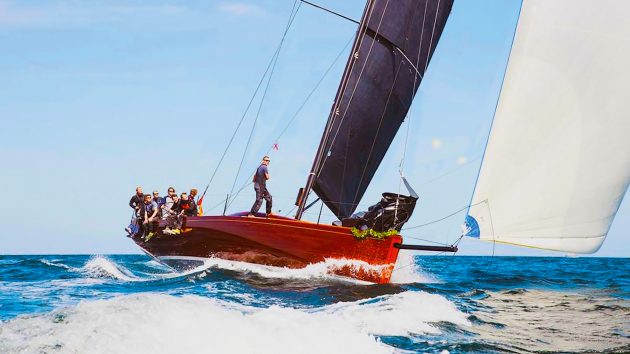
Why would a naval architect and structural engineer used to working with cutting edge materials for America’s Cup teams, including INEOS Britannia , and companies like Airbus, be excited about working with wood?
“It’s quite simple for me,” says French designer Thomas Tison, “Modernity does not neglect where we all come from – on the contrary it makes the best of it. In a way a boat is a heritage, so to ignore wood would be to ignore the essence of yacht design and building.
“Carbon fibre is only an evolution from this heritage and reinstating wood as a modern material increases the number of options a naval architect has for creation and performance.”
Tison designed the stunning, contemporary 48ft offshore racer Elida which launched last year, and currently has a timber/epoxy 40ft high-end daysailer on the drawing board. To optimise Elida ’s weight and stiffness Tison tested three different timber and glue laminates at an Airbus facility. “What we found was very interesting,” he told me. “The existing data was 20 years old, but now we can carefully select the glue and timber, so the figures for our laminates were stiffer than predicted, with the sitka spruce an order of magnitude better than expected.”
Elida is built of diagonally planked sitka spruce covered with a 3mm mahogany veneer. Additional internal stiffening is provided by local layers of 200g carbon fibre. The result is a very stiff structure – projected forestay loads match those used on TP52s, yet the total weight of the 48ft hull shell is only 1,000kg.
Tison’s next project is a very high end 40ft daysailer. Construction will be an evolution of Elida ’s, giving a strong and stiff structure that meets Category A requirements, yet total displacement is only 3,700kg. He also has a concept under way for a 45m superyacht built in a similar manner.

Outlier is a cold-molded custom 55-footer designed by Botin. Photo: Billy Black
Traditional skillset
The enthusiasm naval architects young and old have for wood/epoxy composite construction is striking. Many of today’s stand-out new designs on both sides of the Atlantic are built this way and it’s often the best option for one off builds and short production runs. Key advantages include stunning aesthetics, stiff, lightweight structures and excellent longevity.
Today British yard Spirit Yachts is perhaps the most well-known specialist in this form of construction and their wood-as-art concept is well documented, including the sculptural approach taken with the Spirit 111 Geist . However, examples of other yachts abound, including Rob Humphreys’ Tempus 90 superyacht. This was built in Turkey, which unlike many countries never lost its wooden-boat building industry. As a result plenty of yards today are familiar with working with epoxy/timber composites. And many other top-notch recent wooden yachts have been built there, ranging right up to superyacht size, including Andre Hoek’s PC Yacht range and a number of his Truly Classic designs.
Britain has its own strong tradition of wooden-built designs: the Elephant Boatyard on the River Hamble has a long history of building, and maintaining, timber/epoxy yachts, including the Barracuda 45 built for Bob Fisher in the late 1980s.
Wood was the medium successful IRC raceboat designer John Corby made his name with in the 1990s and 2000s. And it was the choice of one of the UK’s most successful yacht designers, Stephen Jones, for his own 46ft one-off Meteor , launched in 2006. She was built in Grimsby by Farrow and Chambers, which also built two cedar epoxy yachts for former Yachting World editor Andrew Bray.
On the other side of the Atlantic, several New England yards are active in building new custom and semi-custom yachts in wood/epoxy. Notable recent examples include the Lyman-Morse 46, Brooklin Boat Yard’s Jim Taylor-designed 44ft Equipoise , and the Botin custom 55-footer Outlier . A long list of other notable recent launches include Anna , a 65ft Stephens Waring design built by Lyman-Morse and launched in 2020.
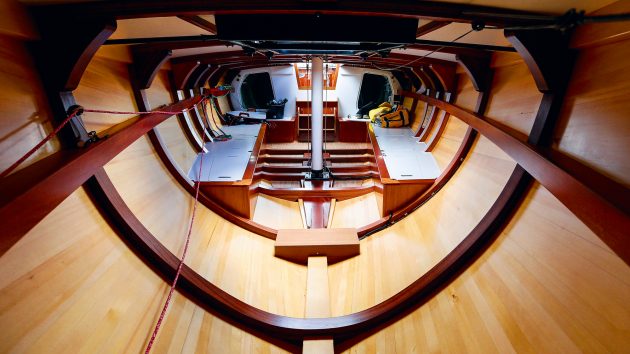
The beauty of wood inside a hand-crafted Spirit. Photo: Paul Wyeth
Build techniques
UK-based designer Rob Humphreys has a long association with this build method, having designed his first vessel in wood in the late 1970s, followed by a string of others, from 22-footers to superyachts, over the following decades. Humphreys remains keen to design more: “The only thing that’s holding us back really is an issue of market education,” he told me.
The medium is often poorly understood, with few people realising the benefits and many assuming it has the same drawbacks as traditional timber construction, or that the technology hasn’t moved on since cold-moulded wooden boats of the 1960s. These were built with resorcinol glues that were originally developed in the early 1940s, but required considerable clamping pressure to create a reliable bond and couldn’t be used as a coating to protect timber.
The epoxy revolution, driven enthusiastically by brothers Meade, Joel, and Jan Gougeon in Michigan in the early 1970s, marked a turning point for boatbuilding. “They got chemists to reconfigure epoxy to be runny enough to saturate the wood rather like a varnish,” explains Stephen Jones.
Even though epoxy doesn’t penetrate deep below the surface of timber, it sticks so well that, unlike paint and varnish, it forms a genuine barrier that keeps water out of the timber in the long term. As a result these boats have potential to last as long as any fibreglass structure.
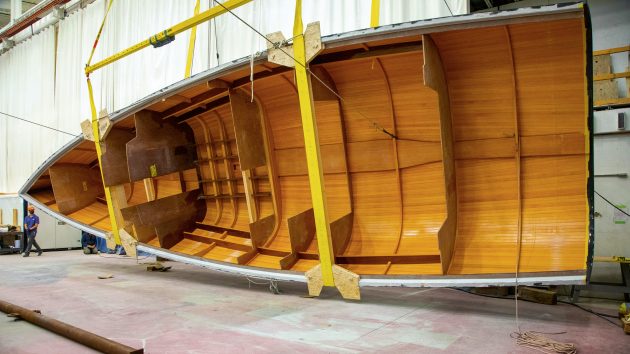
Lyman-Morse 46 hull completed and being turned outside the boat shed. Photo: Alison Langley/Lyman-Morse
There was another key advantage. “It could also be thickened as required for glueing and, most importantly, gap filling,” adds Jones. This significantly speeds up the build process. These vessels are generally inherently stiffer and lighter than conventionally built fibreglass yachts and it was a preferred build method for performance yachts before cored composites became reliable.
Meade Gougeon’s 35ft trimaran Adagio , launched in 1970, was the first large all epoxy bonded and sealed wooden boat built without the use of mechanical fasteners (and is still sailing on the Great Lakes over 40 years on). Three years later the brothers built the Ron Holland-designed 41ft IOR Two Tonner Golden Dazy , ahead of a slew of further designs including a 60ft trimaran for Phil Weld’s 1980 OSTAR single-handed transatlantic race , before race organisers imposed an upper size limit. Weld subsequently had the 50ft timber/epoxy tri Moxie built by Walter Greene, in which he won the OSTAR.
Over the years precise construction methods have varied, although all but a handful of boats are built with several layers of timber with the grain running in different directions to create a stiff structure. Some have a purely cold moulded construction, with larger boats often employing four or more layers laid at around 90° to each other. This creates a lightweight and stiff structure that can be protected from impact damage with epoxy and glass cloth. The Lyman-Morse 46, for instance, is built of four layers of vacuum glued Douglas fir and western red cedar.
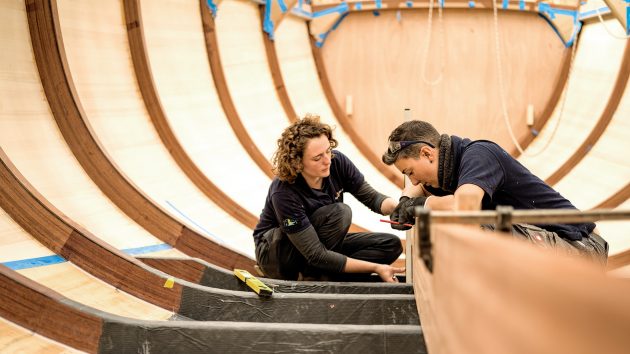
Hand-built expertise at the Spirit yard in Suffolk. Photo: Spirit Yachts
Others start with a layer of narrow planks, termed strip planking. This had been a construction method long before the use of epoxy, but it became much more popular thanks to the development of the Speed Strip technique by Sunderland timber merchant Joseph Thompson & Co (now renamed NYTimber) with help from Farrow and Chambers. The planks have a loose tongue and groove profile, allowing them to neatly conform to the hull shape and giving space for thickened epoxy glue.
Speed Strip also eliminated the need for scarfs to be cut where planks are joined and reduced the number of mechanical fasteners needed. This reduced planking time by a quarter, and clean up and fairing time by 70%. An additional advantage, Jones says, is the “predominance of fore and aft timber strips/planks increases global hull stiffness – the ability of the hull to resist rig loads.”
Around the same time Humphreys was also working on ways to reduce build times. The hull of his H22 sportsboat, which was available as a flat-pack kit with CNC cut components, could be assembled from scratch in a few hours by one person. I know of 40ft offshore racing yachts that were planked up in a week.
Strip planked boats can be built over laminated frames that become part of the final structure, and don’t require a mould that is subsequently discarded. These frames are surprisingly quick and easy to create – at Spirit Yachts, for instance, they’re assembled on full-size print outs of the boat’s plans laid over a plywood floor. This allows each piece of timber to be bent by hand into exactly the right shape and held in place using spikes driven into the floor. They’re then clamped together in situ while the epoxy cures.
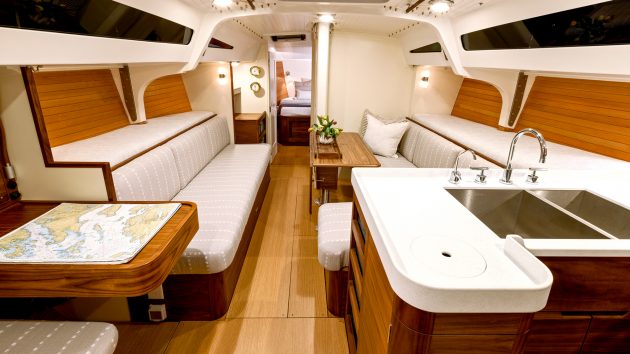
The Lyman-Morse 46 interior shows off its timber construction, with plenty of white painted surfaces for an airy feel. Photo: Alison Langley/Lyman-Morse
Originally cedar was used for Speed Strip planks as it’s lightweight yet very resistant to rot, although other species with similar properties, including Douglas fir and sitka spruce, are also suitable. Typically two thinner outer layers of double-diagonal planking are added outside the strip planking.
In the case of Zest , our 36ft Rob Humphreys design built by Farrow and Chambers in 1992, this forms a 20mm-thick tri-axial construction with the grain of the timber oriented in three different directions. Larger yachts may have four or more layers outside the strip planking and a few boats have an additional transverse skin to help strengthen the area around the keel.
Impact protection
In all cases the whole lot is glued together and sealed from water ingress with epoxy. Therefore no more maintenance is needed than for a fibreglass hull and it will never succumb to osmosis.
Jim Taylor, designer of the 44ft Equipoise and 50ft Rascal , both recently built by Brooklin Boat Yard in Maine, says that in North America this construction is likely to be referred to as cold moulded, with the term referring to the outer layers, rather than the inner skin of strip planks.
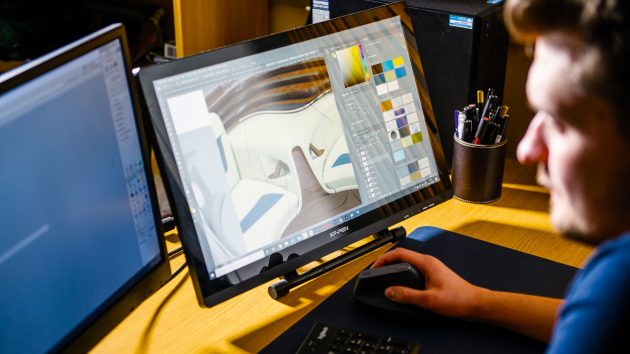
Modern wooden builds created using latest CAD at Spirit Yachts. Photo: Spirit Yachts
Equipoise was built with a first layer of fore-and-aft tongue and groove larch planking which is epoxy bonded to the laminated keel, keel floors, bulkheads and ring frames. Outside of that two layers of diagonal 3/16in (5mm) paulonia were vacuum bagged at +/-45° to the initial planking. Then a further layer of tongue and groove larch was laminated over the paulonia, again in a fore and aft orientation. Outside that is a protective layer of epoxy/glass. Displacement is little more than six tonnes, despite an unusually large 44% ballast ratio, allowing a large rig without the drawbacks of excessive draught.
“There is a whole lot to like about this type of construction,” Taylor says. “The approach is cost effective and the result is extremely attractive on many levels. The boats are light, strong, tough, quiet and well insulated thermally. A bright finished inside skin can be integrated into an especially elegant interior, the construction materials are environmentally sustainable, and there’s not a lot of waste. They’re not as light as carbon skins over lightweight core, but they are much more liveable and not nearly as fragile or as expensive.”
The outer glass/epoxy sheathing can vary from light cloth for impact protection, through to heavier laminates that add structural strength in high load areas such as around the keel. A few boats have glass only outside, rather than additional layers of timber, but these heavier laminates need more work and filler to create a fair surface.
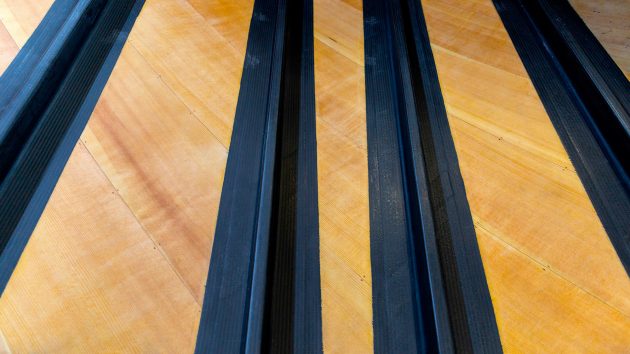
Carbon stiffening for Elida. Photo: Emeric Jezequel
Of course, if the outer sheathing is punctured, then it will need to be repaired quickly, but a quick application of epoxy filler is all that’s needed until a neat long-term repair can be made.
Developments and refinements over time include vacuum bagging the various layers of timber together, along with the external protective layers of glass cloth. At the high end carbon reinforcement is increasingly used strategically to add further stiffness where necessary, without a significant weight penalty.
Elida ’s varnished topsides look stunning, while those of the 1987 Humphreys-designed Apriori and 1988-built Old Mother Gun of 1988 still look great. There’s therefore a huge temptation for anyone building a wooden yacht to opt for similar finishes. However, it’s important to note in these cases the epoxy needs a more traditional varnish for UV protection and that can require a lot of maintenance. On the other hand, today’s polyurethane paints can last up to a decade in dark colours and Meteor ’s original white paint from 2006 still looks almost new.

L’Été is a new 40ft daysailer design by Thomas Tison.
Modern look
On the other hand, varnished bright work on deck and coachroof sides are subject to less wear and tear than topsides. Jones says these are easy to prep for varnishing if designed with simple surfaces without fiddly detail. The cleaner style of modern classic deck structures also reduces water retention, so surfaces dry quickly. “It can still look the part but becomes less onerous to keep,” says Jones.
Below decks it’s easy to fall into a trap of showing off so much natural timber that the interior becomes dark; a strategic mix of white painted panels and clear timber finishes gives a much brighter result. The Spirit 72 , for instance, has satin painted panels and a carefully planned LED lighting system to enhance the warmth of the natural timber.
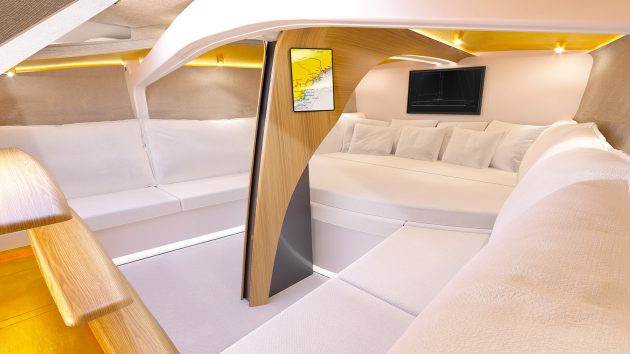
The Spirit 111 has a sculptural cockpit and interior. Photo: Spirit Yachts
Hull windows are possible and, even if maintaining a classic external appearance is a priority, it’s possible to allow a lot of light in from the deck. Spirit Yachts’ trademark fantail window is an excellent example of this.
Alternatively, interiors can be absolutely contemporary in style, as seen in RM Yachts’ 29-43ft range of plywood/epoxy performance cruisers. Plywood also offers excellent stiffness in relation to weight and is an ideal medium for today’s chined hull shapes. At RM all the pieces for an entire boat are delivered on pallets, ready for immediate assembly. Hulls are built over frames of substantial chipboard set up on jigs. Assembling a hull is therefore a straightforward process that doesn’t require a full mould.
The Ace 30 scow bow short-handed IRC raceboat also employs plywood/epoxy construction. It’s an approach the builder says considerably reduces the carbon footprint of building each boat.
Matt Newland of Swallow Yachts tells me their Whisper 300 retro-style planing motor cruiser has demonstrated that at sizes above 30ft an epoxy/timber construction can compete directly on labour hours with conventional fibreglass boatbuilding. The company’s next model, the Bay Cruiser 32, will be a traditionally styled, but very lightweight and quick, 32ft trailerable weekender made of clinker-style plywood and epoxy.
Other forthcoming projects include a range of 45-70ft modern classics by Stephen Jones and illustrator/designer Jonty Sherwill that will be built by the Elephant Boatyard.
These boats will also be more sustainable than their contemporaries built using conventional glass fibre or more advanced composites. The quantity of epoxy used for the build is small and bio-sourced resins can be used without the requirement for a full size mould. The result is that the carbon footprint associated with building the Ace 30, for instance is 1.9 tonnes, but would be more than three times that value for a boat of conventional construction, even before accounting for building the moulds.
If you enjoyed this….
Yachting World is the world’s leading magazine for bluewater cruisers and offshore sailors. Every month we have inspirational adventures and practical features to help you realise your sailing dreams. Build your knowledge with a subscription delivered to your door. See our latest offers and save at least 30% off the cover price.

- Search forums
- Sailing Anarchy
Constructing a wood-plywood-epoxy 30 ft sailboat
- Thread starter zloitapok
- Start date Sep 3, 2023
More options
- Sep 3, 2023

- Thread starter

Overlord of Anarchy
Nice. Please keep updating as you progress.
Super Anarchist
zloitapok, I am interested too! I am considering a similar project in the near future. No offense, but my main question is regarding the time spent. Do you clock your time? Do you know how many hours you spend for each task/phase? How does it compare to the 3000 hrs from the designer estimates? Please keep details coming!
What stage of the build are at with 5000 hrs? I would have thought mostly finished...
- Sep 4, 2023

- Sep 5, 2023

slug zitski
I’ve never used puzzle joints it will be interesting to learn how they perform over time …things like print thru
slug zitski said: I’ve never used puzzle joints it will be interesting to learn how they perform over time …things like print thru Click to expand...
zloitapok said: I reinforced the puzzle joints at critical places with additional plywood overlaps inside the case, just in case, don't have a pic at hand, unfortunately. Set hull to its place was one of the fastest operation. Click to expand...
slug zitski said: In a past plywood build many labour hours and much epoxy was saved by precoating the plywood and timber before cut and assembly Are you using plastic nails, staples ? Click to expand...
RAPTOR® Nails and Staples | Polymer Composite Plastic Nails, Plastic Staples & Plastic Fasteners
Thanks slug zitski ! I coated plywood after installation. If I coat untrimmed plywood sheets with epoxy, where go epoxy at scraps after cutting sheets? That's why I'm wondering how it can save epoxy. Roughly 5-10 percent of the material is scraps. Checked raptor nails - interesting thing, I didn't use such yet.
I think the savings that Slug is talking about is first and foremost time. It is so much easier to coat and sand a sheet of plywood on an horizontal table or sawhorses than in position on the boat... Regarding the puzzle joints, my understanding is that if designed correctly, the bonding area between the 2 sheets of plywood should be the same as a good scarf joint. The contact surface is basically the linear length of the puzzle trace line times the plywood thickness; make the puzzle line "convoluted" enough to have the required length. Zloitapok, do you do the assembly of the puzzle joint beforehand, on a flat surface and then install the whole panel on the hull? Or do you do the puzzle joint assembly "in situ", directly on the hull frame? It seems to me that the first option will help have invisible puzzle joints (avoid the inprint issue raised by Slug), but at the cost of having to deal with very large/long panels to install on the hull. And the opposite for the second option. Choose your poison...
Laurent said: I think the savings that Slug is talking about is first and foremost time. It is so much easier to coat and sand a sheet of plywood on an horizontal table or sawhorses than in position on the boat... Regarding the puzzle joints, my understanding is that if designed correctly, the bonding area between the 2 sheets of plywood should be the same as a good scarf joint. The contact surface is basically the linear length of the puzzle trace line times the plywood thickness; make the puzzle line "convoluted" enough to have the required length. Zloitapok, do you do the assembly of the puzzle joint beforehand, on a flat surface and then install the whole panel on the hull? Or do you do the puzzle joint assembly "in situ", directly on the hull frame? It seems to me that the first option will help have invisible puzzle joints (avoid the inprint issue raised by Slug), but at the cost of having to deal with very large/long panels to install on the hull. And the opposite for the second option. Choose your poison... Click to expand...
Epoxy waste is an issue Premix fairing and fillet epoxy is great for reducing waste . A major problem with wood epoxy boats is toxicity Work super clean and alway be aware The epoxy dust on surfaces in your shop is toxic
mckenzie.keith
Aspiring anarchist.
slug zitski said: Epoxy waste is an issue Premix fairing and fillet epoxy is great for reducing waste . A major problem with wood epoxy boats is toxicity Work super clean and alway be aware The epoxy dust on surfaces in your shop is toxic Click to expand...
Very impressive! The lumber/timber you're using looks like an Oak of some sort... What is it?
- Sep 6, 2023

Latest posts
- Latest: Ease the sheet.
- 2 minutes ago
- Latest: Chris in Santa Cruz CA
- 3 minutes ago
- Latest: animeproblem
- 4 minutes ago
Sailing Anarchy Podcast with Scot Tempesta

From the origins of cruising yachts to wood-based naval construction, until the advent of plywood-epoxy yacht building: how RM Yachts has modernized a unique building process.
What is plywood?
Plywood is a material that is currently used in different sectors, such as:
- construction
- packaging for transportation
It looks like a composite sheet, due to the superposition of crossed, 1 to 4mm thin plies of wood.
Plies are obtained after unrolling wood ridges, stoved during 12 to 72 hours depending on the essences. They are then cut, dried, glued and superposed in crossed ways, before being pressed.
The whole process for building a panel of industrial plywood can be described in twelve steps:
- Cold pre-pressing
- High temperature pressing
- Conditioning
The maximum thickness of industrial plywood is 40mm. Panels are balanced, meaning that the different plies are split in a symmetrical way. Panels are also heterogenic, hygroscopic, and orthotropic (they have different characteristics depending on the three perpendicular directions).
The crossed plies confer to the panels a greater homogeneity and a larger dimensional stability, compared to raw wood.

Plywood panels for structural use have become popular thanks to the synthetic resins in the 20 th century.
RM Yachts’ plywood-epoxy sailboat construction technique
RM Yachts has over 30 years of experience as a French sailboat manufacturer . One of the originalities of our modern cruising yachts is that they are made using plywood , which is assembled on a jig. Our plywood is made in France and comes to us from a factory which supplies laser-cut parts that are ready to assemble.
RM sailboats range in size from 9 m to 14 m, and each model has its own assembly jig on which the planks are positioned and assembled by jointing and laminating. For the vessel’s planking running the whole length of the hull, the parts are butt-jointed by means of a “scarf” joint in which the two ends of the plank are cut slantwise and overlapped, ensuring a very strong, rigid join. The time to build the hull on the jig varies from one model to another, depending on the size of the yacht.
RM boats are fitted with a metal part in the bottom which increases the rigidity of the structure and on which the different types of keels (fin keel, twin keel, or lifting keel) are subsequently mounted.
RM Yachts completes the following different stages to build a plywood-epoxy liveaboard sailing boat:
Coating the hull and shaping the bilges
Once ready on its jig, the hull is then “unmoulded” and, still upside down, moves to the assembly station where the bilges will be coated with epoxy to give the hull its shape.
Laminating the inside of the hull
Whilst the outside of the hull is coated with epoxy, structural lamination is carried out inside the sailing yacht to ensure maximum rigidity. The structural bulkheads are laminated.
Manufacture of the composite deck
RM decks are mostly made of composite produced by infusion moulding to optimise the weight. They are manufactured by the La Rochelle-based company A2J, a neighbour of RM Yachts. Composite is an excellent choice for deck construction, as this technology enables very fluid, rounded shapes to be achieved, which are characteristic of the RM Yachts monohull sailboats designed by the naval architect Marc Lombard.
Cladding and painting the inside of the deck
Whereas the interior bulkheads of our RM sailboats are laminated, and the bilges shaped by applying epoxy hull coating, the deck is given cladding on the inside.
This almost total coverage is completed using plywood, which offers excellent thermal and sound insulation, and additional rigidity. Once this operation is finished, the inside of the deck is painted in a paint booth.
Painting the inside of the hull
Whilst the cladding and paint are being applied to the deck, the hull is turned over and operations begin to install the interior fittings. This starts by the final lamination and then coating of the bulkheads. A primer is then applied before painting the inside of the hull.
Fitting out before the deck is installed
Once the inside of the hull is painted, fitting-out operations prior to installing the deck begin. At this point, the furniture modules made by a local subcontractor are fitted, together with the power and water systems and the engine. All the large or heavy fittings are now in place.
Installing the vessel’s deck can begin
Fitting the deck
The deck of an RM sailboat is installed just after the furniture, the power and water systems and the engine have been fitted in the hull. The deck fittings are mounted. The deck is then positioned and bonded onto the hull followed by lamination, a solution which contributes to the structural strength. The point where the deck meets the hull (the deck edge) is then coated with epoxy and sanded for a perfect invisible join.
Painting the hull
The next stage, lacquering the hull, is one of the longest in building an RM, requiring many different steps separated by drying times.
The RM Yachts shipyard is one of the only ones to paint the hulls of all its boats, thanks to its plywood-epoxy sailboat construction technology.
While the boat is still upside down, the bilges and laminated joints are coated with an epoxy layer. It is then sanded.
Next, a very thick primer is applied by spray gun to correct any unevenness in the surface.
A second thinner, more dilute layer of epoxy primer is then applied to finish. This epoxy “finish” flows better and improves the quality of the finished surface.
It is then sanded again.
Next, an ultra-smooth polyurethane primer is applied.
Once this layer is dry, the completely personalised bi-component polyurethane high-gloss lacquer topcoat is applied to produce the perfect cruising yacht for each customer.
Finishing and fitting the keel
Once the hull has been painted in the paint booth, the final steps can be completed to finish the inside and outside of the RM.
The portholes, interior lighting, electronic equipment, ceilings, panelling, and doors are fitted.
The very last stage before delivery is the installation of the keel. The shipyard offers three types of keels: fin keel (a single keel), twin keel, or lifting keel.
How has our building technique evolved?
Martin Lepoutre, General Manager, RM-Yachts:
“RM Yachts benefits from a unique experience and history of building sailing yachts with plywood-epoxy. Since inception, more than 500 sailboats, from 30 to 45ft, have been built here in our French shipyard, in La Rochelle.
Today, our range of modern plywood sailboats include:
Year after year, we have constantly improved our building process:
- The mannequins have been improved to make sure we can assemble the hull in the best conditions and control the transversal and longitudinal structure.
- The assembly has been improved with fillet sealing, and then the stratification of all the bondings.
- The epoxy resins we use are more and more performant, but also more environment friendly.
RM Yachts is unquestionably the shipyard with the longest experience and track record in this area. Thanks to this efficient sailboat building technology, the achievements are:
- a top quality
- incomparable solidity
- a fantastic performance/displacement ratio
Advantages of plywood-epoxy: why has Marc Lombard selected this material to build RM sailing yachts?
Interview of Marc Lombard, architect of the RM Yachts.
What are the benefits of plywood-epoxy for blue water cruising yacht building?
The benefits are not only for the blue water or expedition yachts, but for all yachts! The benefit of this technology stands in the material itself: plywood-epoxy. Wood is not a dense material and offers an interesting solidity/weight ratio. If you think the other way around, what we first need on a sailing yacht is solidity.
If you build it with plywood-epoxy, you’ll get a lighter boat than its equivalent in aluminum or GRP. If she’s lighter, it means we can build an even more solid yacht for an equivalent weight or build one with a higher load capacity.
When it comes to blue water cruising sailboats, it’s a balance between this light displacement and the ability to benefit from this extra load capacity. If you want a super solid sailboat, she’ll always be lighter than the equivalent in other materials such as iron, aluminum, or GRP.
Raw wood is a hard-to-process material. For the past 25 years, we’ve worked hard with RM Yachts to finetune this plywood-epoxy sailboat construction process and make it economically viable and competitive. It’s quite a challenge, as it costs more money compared to monolithic polyester, but it offers many more benefits in terms of solidity, lightness, and insulation.
When it comes to insulation, the first benefit is clearly a moisture-free atmosphere. There’s no mistiness with 18mm planking, while iron or aluminum would require additional insulating materials. Not to mention the easiness to repair plywood-epoxy.
(ActuNautique.com, 2016).

Marc Lombard and the sailor of the future, Voile Magazine, April 2021.
25 years ago, Marc Lombard designed the RM800. An easy to clean, easy to store, easy to live, great little boat. A seaworthy design, able to sneak in the tiny coves thank to her reduced draft, but also capable of offshore passages. In a nutshell, a yacht in which Marc Lombard put the best of himself. “At that time, the twin-keel yachts were solely English”, but he worked hard to make them more performant. Using plywood-epoxy, that he had discovered when working with Walter Green and the West System technique, he knew he was in the right direction. Since inception, RM Yachts range has evolved and the sailing yachts have become more and more performant and comfortable, yet elegant. But they have kept this original philosophy of seaworthiness. RM Yachts are made to munch miles, and their owners usually buy them for this purpose. Even if they are looking for comfort. A requirement Lombard takes seriously into account, when he reduces the number of steps in the companion way, between the cockpit and the saloon area. Not yet like a cruising catamaran, but that’s the idea behind it. RM Yachts will continue to evolve, but maybe not with foils or scow bows! Because all offshore innovations are not necessarily adaptable on cruising yachts. According to Marc Lombard, the question is not about the yachts of the future, but about the sailors of the future. What will be their expectations? What will they look after? A way to underline the fact that we have the yachts that we deserve!
A look back in history
The origins of plywood-epoxy sailboat construction.
Plywood sailing boat building started back in the 1960’s. The first naval architects to use this technique were Harlé, Herbulot or Van De Stadt. In France, they gave birth to legendary yachts such as the Muscadet or the Corsaire. Plywood was lighter, waterproof, and required less maintenance than raw wood.
Sometimes seen as an amateur, non-professional technique, with perfectible finishings, this building process has quickly evolved to finally be mastered by shipyards such as RM Yachts, thanks to Marc Lombard’s design. Today, plywood is combined with epoxy.
This combination with epoxy resin enables an even better waterproofing and facilitates maintenance. Combined with fiberglass, it becomes a fantastic material to build yachts, with a weight/resistance ratio clearly more favorable than the ones of aluminum or monolithic polyester.
The plywood-epoxy used by RM Yachts to build our cruising yachts today can be defined as a wood-composite material.
For the record, a composite material is the assembly of at least two non-miscible components, whose specifications are complementary. the material obtained by this assembly is heterogenic and offers resistance characteristics that the sole components do not have.
What is the « West System »?
Marc Lombard is one of the first naval architects to have imported in France the concept of plywood-epoxy sailboat construction. It is actually a technique that American yacht builders already mastered, thanks to the discovery of a marine-grade resin, called West System, created by the Gougeon Brothers.
The Gougeon family, originally from Chicago, IL, set up a new process: saturating a plywood panel with resin. The first application of this technique was the building of “ice-boats”, designed to navigate on the frozen waters of the great lake’s region.
They eventually designed a few sports multihulls and won a few local regattas and championships. In 1975, they decided to stop competition, and focused on the fabrication of this specific resin, aiming to sell it to other boat builders.
In 1979, they wrote a book on boat construction using plywood-epoxy. This book became the bible for many architects. It was re-edited 5 times, until 2005.

In this book, the Gougeon brothers will explain the virtues and benefits of plywood combined with epoxy, comparing it with other materials used for boat construction. Starting with solidity and rigidity.

Among the various plywood boat building processes, the one preferred by the Gougeon brothers is the “compounded” one. It consists in assembling plies, impregnated with resin, and to press them to obtain a desired given shape.
It is actually the technique that is still used nowadays at RM Yachts.
Below is the 35-footer trimaran “Ollie”, built by the Gougeon Brothers back in 1985.

A manufacturing technique that inspired many
This plywood boat construction technique will be used by Dick Newick to build his first multihulls, but also by Walter Green, in Yarmouth, Maine. Guess what? The latter will welcome the young Marc Lombard as a trainee, when working on “A Capella” for Charlie Capelle, sistership of the little yellow trimaran Olympys, commissioned by Mike Birch, winner of the Route du Rhum in 1978.
“For me, there is no other option for boat building but wood. When you come aboard a yacht, you have to feel something, an atmosphere, some emotions. In a GRP boat, this is quite hard to feel, while in a wooden boat, you’ll immediately feel a soul, a spirit, a strength. There’s something happening because it’s a material that is alive. In terms of solidity, when it is properly worked out, and well maintained, you know it will last forever. A Capella is a great example: she spent a year and a half upside down, tossed by the waves on the beach, and she is still in pristine conditions”
(Charlie Capelle, Voiles & Voiliers magazine, 2014).
About leisure sailing
No one exactly knows when the first sailing boats were used for leisure purposes. The first leisure sailors probably used a mix of sails and oars as auxiliary source of power. Since Antiquity, some ships were used for celebrations, anniversaries, and even races. Sailing on the Nile river and later on the Med has been recorded by antique Assyrian, Phoenician or Egyptian civilizations.
The origin of leisure sailing or “cruising” is more recent and has been found in the Netherlands and the UK.
In 1601, a Dutch named H. Voogt managed to get an authorization to sail from the Netherlands to London, for fun. This marks a kind of milestone in the definition of cruising. But what is the exact definition of leisure? “Use of free time for enjoyment”. That’s a good start, isn’t it?
When it comes to “cruising”, Cambridge’s dictionary says: “the activity of going on a journey on a ship for pleasure ”.
Sailing a yacht for enjoyment, could be another definition. At least, this is the one that corresponds the best to RM Yachts philosophy!
Nowadays, leisure sailing comes in many forms and liveaboard sailboats are used by couples, families and solo sailors for port-hopping, coastal cruising, bluewater sailing, ocean crossing, etc.
Sailing for pleasure is probably the best definition of yachting. At least that is how RM Yachts defines it.
About “yacht” origins.
The English word “yacht”, today commonly used to design a sailing vessel, has Dutch roots: the jaght schip was originally used in the late 16 th century. The verb jaghen meaning chasing, going after, and the word schip meaning ship or vessel. This etymology underlines the fact that the notion of a fast sailing yacht has been key to the development of leisure crafting.
Since 1989, RM Yachts continues to foster this definition: our monohull sailing yachts are fast, and comfortable!
Cruising and leisure sailing will give a second chance to sailing. In the second half of the 20 th century, this activity will be democratized. A good example of this spectacular boom is the Vaurien, an affordable and solid 13ft dinghy. Built using just one single sheet of plywood.
How were the first cruising yachts built?
It seems the construction of sailing boats was done using the materials that could easily be sourced locally. Logically, wood, easy to cut and assemble, has been mostly used in different parts of the world, until plywood and its many benefits came in.
Keep in Touch' Restons en contact
We will send you RM Yachts News (Only) to make sure you are up to date. Recevez (seulement) nos infos, pour être sûrs de ne rien rater !
- FR - Français
- EN - English
Questions? Call Us:

The Gougeon Brothers On Boat Construction
This renowned boat construction book was written by epoxy pioneer Meade Gougeon, a founder of Gougen Brothers, Inc.
Decades of experience building with wood and epoxy are compiled in this classic on wood/epoxy boat building, popularly known as cold molding . Extensive chapters describe lofting, safety, tools, and construction methods with the aid of hundreds of detailed illustrations and photographs. This 5th edition includes new and updated material and a revised layout for easier navigation. Used as a textbook in many boat-building schools. There are more than 100,000 copies in print.
Hardcover, 406 pages
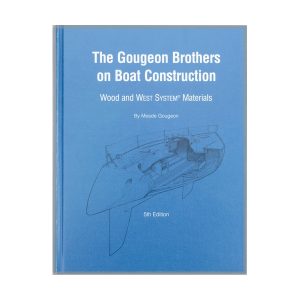
Boat Construction Book – details
The Gougeon Brothers on Boat Construction: Wood and WEST SYSTEM ® Epoxy was first published in 1979. As originally conceived, this boat construction book was an introduction to the techniques of “modern” wooden boat building popular from 1960-1980. Its focus, as its title suggests, was how to mate wood with epoxy to form a composite that has physical characteristics superior to either component by itself and is stabilized from the effects of moisture. This development of wood/epoxy composites revolutionized the use of wood as an engineering material.
The original boat construction book was well-received, and we updated it in 1982 and 1985 to reflect changes in materials and techniques. It has continued to sell well and has introduced thousands to wood/epoxy construction techniques. It has also been used by marine trade schools and apprentice programs as part of their curriculum. In short, The Gougeon Brothers on Boat Construction book has become a respected member of the canon of boat building books.
Much has changed since 1985 as modern wooden boat building has evolved. Several of the methods we discussed, such as variations on strip planking and hard-chine construction, have become more popular. Others, such as the mold and stringer-frame methods, are now used infrequently except for molds and prototypes. In 2005, aerospace composites are in common use. Hybrids using wood and advanced composites, including aramid, S-glass, and carbon fiber, are being explored. So too are the uses of non-traditional wood species. Such uses are possible because of the ability of epoxy resins to protect and bond wood and overcome traditional durability concerns. In short, the choices for the wooden boat builder and customers in the early 21st century have grown immensely.
Nonetheless, the techniques described in The Gougeon Brothers on Boat Construction have stood the test of time. In a simple and straightforward narrative, we describe how anyone with a few tools, some wood, and some WEST SYSTEM ® epoxy can turn out a good, safe boat. In addition, we give experienced builders a base of information from which to produce increasingly sophisticated hulls and other structures. For the student, builder, or customer researching options, The Gougeon Brothers on Boat Construction provides a solid understanding of available choices and their nuances.
Changes to the 5th Edition To make The Gougeon Brothers on Boat Construction a richer resource for the 21st-century reader, we have chosen to revise, reorganize, and update the book, but not to rewrite it. To edit out less popular construction methods like stressed skin or stringer-frame construction or replace fundamental building disciplines such as lofting with modern counterparts like computer-assisted design (CAD) would rob the reader of choices. While, after 25 years, the book includes some things that we would no longer do, this information provides a historical perspective on how “modern” wood/epoxy construction evolved and potential techniques that could still be of interest to current builders.
For clarity, we have reorganized the 5th edition of our boat construction book into six sections:
- Fundamentals of Wood/Epoxy Composite Construction
- Getting Started
- Core Boatbuilding Techniques
- First Production Steps
- Hull Construction Methods
- Later Production Steps
The brief history of Gougeon Brothers and WEST SYSTEM epoxy (Chapter 1) and overview of modern wood/epoxy composite construction (Chapter 2) are new. We have also written new prefaces for each chapter, alerting readers to changes or new techniques. In addition, we have included limited new material within the chapters to update information and reflect significant shifts in practice.
Hardware bonding receives greater emphasis in the 5th edition. We have also updated safety information and included current product information. Revised appendices reflect ongoing testing and developments. New photographs show the wide range of successful boats built during the last 35 years using the techniques discussed in the book.
To meet the needs of an international audience, we have also provided metric equivalents for the English measurements used in the book. Where there are standard metric sizes—for sheet plywood dimensions, for example—we give these. For measurements that do have a direct metric equivalent, we use approximations based on common metric standards or round off for clarity. Thus, this updated 5th edition of The Gougeon Brothers on Boat Construction not only continues to make fundamental information on “modern” wood/epoxy boatbuilding readily available to readers. Through its revisions, it also provides a contemporary context for understanding these materials and techniques.
Thus, this updated 5th edition of The Gougeon Brothers on Boat Construction book not only continues to make fundamental information on “modern” wood/epoxy boatbuilding readily available to readers. Through its revisions, it also provides a contemporary context for understanding these materials and techniques.
While we are planning new publications to cover changes, choices, and considerations in wooden boat building for the 21st century, we continue to print The Gougeon Brothers on Boat Construction: Wood and WEST SYSTEM Epoxy as a snapshot in time—modern wooden boat building as it emerges from traditional methods to embrace new materials and new technologies.
The Gougeon Brothers on Boat Construction: Wood and WEST SYSTEM Epoxy started as a labor of love in 1976. Meade Gougeon, with help from brothers Joel and Jan, worked on the original for over two years, finally bringing it to publication in 1979. Rob Monroe was part of the original team, contributing drawings and text, particularly material on lofting. Kay Harley served as editor, and the writing would not have been possible without her patient encouragement and guidance. Barbara Livingston, Lily Jarmin, and Loren Mohn assisted with the publication. This 5th edition of the book builds upon its predecessors.
As explained in the preface, we decided to substantially revise, reorganize, and update The Gougeon Brothers on Boat Construction, but not to rewrite it. From the technical side, this edition is the distillation of twenty years of feedback from professional and amateur boatbuilders whose comments and questions to the Gougeon technical staff have molded every element of the book. Brian Knight and Tom Pawlak have served as the technical editors for the 5th edition, working for over a year reviewing, updating, and editing material. Their attention to detail and sense of quality bears on every page. J.R. Watson, Jim Derck, Glenn House, Patrick Ropp, Bill Bertelsen, and Rob Monroe have also provided content and additional review.
Kay Harley returned as editor and prime mover, helping bring the many years of discussion about a new book to reality. Her respect for the technical expertise and individual writing processes of multiple authors combined with her critical eye and editing experience to shape the project. Mike Barker’s work as a design editor and production coordinator has also been crucial to this edition. Not only has Mike made new drawings, revised others, and created an updated portfolio of photographs reflecting thirty-five years of wood/epoxy boat construction; he has also managed all of the details of multiple drafts and the shift to digital production with this edition of the boat construction book.
We also thank Marjie Johnson at Golden Graphics for the layout and Todd Fisher at McKay Press for printing.
Finally, we thank Meade Gougeon for his encouragement throughout, all of the Employee Owners of Gougeon Brothers, Inc., and family members who helped this project along.

- News & Views
- Boats & Gear
- Lunacy Report
- Techniques & Tactics
WOOD BOAT CONSTRUCTION: Practical and Traditional
HUMANS HAVE BEEN building boats out of wood for many thousands of years. Many assume therefore it must now be obsolete. Wood certainly does not lend itself to mass production the way fiberglass does, though there were a few builders who manufactured wood boats on something like a production basis not long before the advent of glass. Wood does have some distinct virtues. It is light, even compared to modern building materials, and in terms of tensile strength is stronger per pound than common electrical-grade fiberglass. In terms of stiffness, it is stronger per pound than S glass, E-glass, and Kevlar. In terms of its total structural efficiency, it is better than all of these materials, including carbon fiber.
One big problem with wood, however, is that certain lifeforms like to eat it. Various fungi can infest and consume it, causing what is known as dry rot. Marine borers like the Teredo worm, or boring insects like carpenter ants and termites, can also chew their way through a boat pretty quickly. Wood also rots when it gets too wet, is easily ignited, and is soft, with poor abrasion resistance. Structurally, in one important sense, it is deficient in that it is much less dense than other materials and thus takes up a lot of space. A wood hull must normally be much thicker than an equivalent glass hull, and its interior structural parts must also be larger. Indeed, wood cannot be used at all to make certain small parts that carry great loads (such as bolts, tie-rods, and rigging wire) simply because it is too soft and too fat to fit.
Perhaps the biggest advantage wood has over any other material, especially when it comes to building boats, is that it is inherently romantic. For this reason alone, it is likely someone somewhere will always be building wooden cruising boats, and that other people will always be sailing them.
Plank-on-Frame Construction
This is the most traditional method of building a wood boat. The principle is simple, though the details are complex. The fundamental structure of a plank-on-frame vessel is defined by a keel, which is the horizontal backbone of the hull; a more vertical stem, which forms the bow; and a vertical sternpost (plus, in the case of many yachts with long overhangs, a much less vertical horn timber that terminates in the transom), which forms the back of the boat. On deep-keel vessels, especially on sailboats, there is also often what is called deadwood fastened beneath the keel. This forms part of the lateral plane well below the waterline and makes up a good part of what sailors normally call the “keel,” particularly its aft section. The forward section is normally inhabited by a solid casting of metal ballast, preferably lead, that is fastened to the bottom of the boat.
A full-keel plank-on-frame sailboat under construction. You can see both the deadwood and the lead ballast down low (Photo courtesy of Rockport Marine)
Fastened to the spine created by these parts is a series of parallel transverse frames that describe the vessel’s hull form. To help support the hull, lateral stringers are installed inside the frames. The skin of the hull consists of a series of planks fastened to the outside of the frames. These planks may be laid on the frame with their edges slightly overlapping, which is known as clinker, or lapstrake, construction. This is often done with smaller boats, but hardly ever with larger boats, as the many ridges formed where the planks overlap greatly increases wetted surface area. Alternatively, planks can be laid on the frame edge to edge, creating a fair, smooth surface, which is known as carvel construction. To make the hull watertight, the seams between carvel planks must be caulked with long strands of cotton and/or oakum.
Open seams on a carvel hull awaiting caulking. Note the tufts of cotton hanging out where caulking is underway (Photo courtesy of Rockport Marine)
The deck of the boat, meanwhile, is supported by a series of transverse deck beams, the ends of which are fastened to lateral shelves installed along the inside of the hull at the top of the frames. Traditionally, the deck consists of planking fastened to the deck beams with all seams, again, carefully caulked. Another common way to seal decks, often used on yachts, is to cover the planking with painted canvas. These days, however, many wood decks are simply good-quality marine plywood sealed with epoxy.
Even from this abbreviated description it should be clear this is a labor-intensive way to build a boat. Much skill is also required. Just selecting wood to build with is an art, as there are numerous criteria to meet. The best wood should be cut only in winter to minimize the retention of moisture and microorganisms. It should then be air-dried in a climate-controlled environment for as long as possible–many months at a minimum. The lumber should also be carefully milled to produce planks and pieces with the wood grain properly aligned to carry anticipated loads in the boat. Finally, if you’re truly fanatic, all pieces should be hewn to size by hand, rather than ripped with power tools, as traditional hand tools do less damage to the fiber of the wood and make it much less prone to fungal attacks.
The biggest issue is embraced in that single verb “to fasten.” A plank-on-frame boat consists of hundreds of pieces of wood, all of which must be carefully shaped and then bound together by thousands of small metal fasteners. Even if you use the best fasteners (silicon bronze screws and bolts are preferred, though Monel is technically superior) what ultimately limits the strength of a plank-on-frame boat is not the wood it is made from, but the fasteners holding it together.
This weakness manifests itself in various ways. First, because they are made from many different pieces, and in particular because so many plank seams are permanently submerged, plank-on-frame boats are apt to leak. Many are continually taking on water when afloat, and normally the only variable is the rate at which water is coming aboard. Invariably this increases when conditions get worse. I once sailed across the North Atlantic aboard a plank-on-frame schooner–one time we almost sank; the other time we did (though, fortunately, this was in a river on the other side). Prior to the voyage, a friend warned me: “A wood boat is nothing but a collection of leaks loosely organized as a hull.” Nothing in my experience proved him wrong.
Plank-on-frame boats also often have deck leaks. The problem here is that wood in the deck is constantly swelling and shrinking as it gets wet and dries out. If the deck has open seams, all this expanding and contracting is apt to create gaps somewhere. Even with painted canvas covering the seams, or with a solid plywood deck sealed in epoxy, there are again many fasteners securing hardware, each offering a potential route for water intrusion. Other structures sprouting from the deck–deckhouses, hatches, raised gunwales, etc.–also present seams and cracks where they join the deck that water can eventually seep through.
World-famous small-boat cruiser Larry Pardey waters the deck of his boat, Taleisin , to keep the planks swollen tight. That’s his equally famous wife Lin peering out the companionway. Larry is a master boatwright (he built Taleisin himself) and maintains his boats scrupulously
Finally, plank-on-frame boats can be a bear to maintain. All that wood, above the water and below, needs to be either painted or varnished on a regular basis. Leaks must be policed and stanched if possible. Moist areas in the structure must be sought out, constantly monitored for rot, and replaced if the rot gets out of hand. As Bernard Moitessier once put it: “The maintenance of my wooden boats had always confronted me with delicate problems and required real qualifications, for I had to be ‘Doctor of Rot,’ ‘Doctor of Teredos’ and ‘Doctor of Leaks.’ ” Some people enjoy this sort of work and anxiety. Most, however, like Moitessier, would much prefer to just go sailing.
Wood-Epoxy Construction
Plank-on-frame boats still have a strong cult following and a relatively large number of older wooden yachts are sailed and maintained by devoted owners. Some new plank-on-frame yachts are also built from time to time, and a few boatyards–the most prominent are probably Gannon & Benjamin on Martha’s Vineyard and Rockport Marine in Maine–even specialize in this sort of work. But the most exciting wooden boatbuilding these days is done with composite wood-epoxy construction.
The key ingredient is modern epoxy, which is not only a tenacious adhesive, but is also highly elastic and nearly impermeable to water. By sealing and coating every piece of wood in a boat with epoxy, and by using epoxy to help glue these parts together (aided, too, by the judicious use of metal fasteners), it is possible to take full advantage of wood’s excellent structural properties while negating its tendencies to rot and swell and contract when exposed to water. Epoxy also protects the wood from hungry creatures that want to eat it.
Furthermore, a wood-epoxy hull forms a one-piece monocoque structure that cannot leak unless punctured. In most cases, to improve abrasion and impact resistance, the hull and deck are also sheathed in one or more layers of fiberglass cloth. The result is a boat with many of the virtues of fiberglass, with the added benefits of built-in insulation, plus all the fuzzy romantic feelings inspired by a genuine wood finish.
There are many ways to construct a wood-epoxy boat. One could, for example, build a wood-epoxy plank-on-frame vessel, but this would be labor intensive and the boat would be needlessly heavy and thick. In practice, there are three basic approaches–strip-plank construction, sheet plywood construction, and so-called cold-molded construction. Each has many variations, and to some extent different techniques can be combined in a single hull.
In a simple strip-plank hull the frame is an important part of the structure, and the strip planks, which are narrow–with a square section shape, are both attached to the frame and edge-nailed to each other. Boats were often built like this in the traditional manner (and are still built) without being encapsulated in epoxy. In more modern variations, there is more reliance on epoxy, fiberglass sheathing, and internal accommodations structures (including bulkheads) to support the hull, with framing reduced to a minimum. Some of these vessels are essentially fiberglass boats with solid wood cores. Strip-planked wood-epoxy hulls are probably the most common type built today, as they are generally the most cost effective.
Sheet plywood construction is the least common type, at least as far as larger sailboats go. Mostly this technique is used for smaller boats like dinghies, skiffs, and daysailers. The one major exception are Wharram catamarans, which are usually built of plywood, and may or may not be coated in epoxy. In a plywood boat of any size, a substantial amount of framing is needed, but construction otherwise is relatively simple and fast, as large sheets of plywood can be set in place more easily and quickly than many narrow planks. Plywood construction does limit design options. Normally plywood hulls are hard-chined, although lapstrake construction–as seen, for example, in some very interesting Dutch Waarschip designs–can also be employed.
The third major variation, cold-molded construction, is more properly described as diagonal-veneer construction. Here the hull is composed of several layers of thin wood veneers that are laid up on a diagonal bias over light framing or a jig. The layers of veneer are oriented at right angles to each other and are glued together and stapled in place until the epoxy sets up. Often there are one or more layers also oriented laterally at a 45-degree angle to the diagonal layers. By laminating thin sheets of unidirectional veneer atop one another like this, a light monocoque structure that is strong in multiple directions can be created. These cold-molded boats are, generally speaking, the lightest of wood boats, but this method of wood construction is also by far the most labor intensive. The technique is shunned by some, but is favored by those for whom weight reduction is critical. It is also sometimes used in conjunction with strip-planking, with layers of diagonal veneer laminated over a planked hull in place of fiberglass sheathing.
This Wharram-designed Islander 65 catamaran is being professionally constructed of diagonal veneers (Photo courtesy of James Wharram)
The hull of this large cold-molded yacht has diagonal veneers being laid over strip planking (Photo courtesy of Hodgdon Yachts)
The term cold-molded is something of an historical anomaly. The first laminated wood hulls were composed of veneers laid up in female molds and glued together with adhesives that could only cure in an oven. The expression “cold-molded” was born later when it became possible to use adhesives that cure at room temperature. The term is still used to describe diagonal-veneer hulls, but not other types. Technically speaking, any wood-epoxy hull laid up at room temperature can be said to have been cold-molded.
Whatever they are called, wood-epoxy vessels in fact make superb cruising boats. The only problem is that wood-epoxy construction does not lend itself to series production. If you want a new wood-epoxy boat, you must commission its creation as a one-off, and many people with money to burn have done just that. Many modern wood-epoxy boats are based on traditional designs but take full advantage of modern design and construction techniques to minimize weight and maximize performance. Others are full-out modern superyachts measuring over 100 feet in length and a few are flat-out race boats. For example, Bruce Schwab’s very intriguing Open 60 OceanPlanet was a wood-epoxy boat. So, too, was Holger Danske , an early BOC boat designed by Dave Gerr that had a phenomenally low displacement/length ratio of 40. This is one of the lowest D/L ratios ever achieved in an ocean-racing monohull, which gives some idea of just how cutting-edge wood-epoxy can be.
Dave Gerr’s ocean racer Holger Danske , a very light boat built out of wood (Photo courtesy of Gerr Marine)
Gusto , a Chuck Paine design, is a modern wood-epoxy cruising boat with more traditional lines (Photo courtesy of Chuck Paine)
Wood-epoxy boats can also, of course, be found on the used-boat market. Recently built boats are relatively rare and normally command a significant premium, but older boats, some dating back to the early 1970s, are often quite affordable. Be sure to have them carefully surveyed, however, as construction techniques have improved considerably in recent years. As with any older boat, there will likely be problems that need addressing.
Related Posts

COASTAL DELIVERY: From Marblehead MA to Southport CT On a Classic Aage Nielsen Sloop

NICK SKEATES ON WYLO II: The Ultimate Barebones Cruiser and his Ultimate Dirt Simple Boat
I love wood boats and have built my share over the years but one thing that is worth mentioning is that a wood boat behaves differently in the water compared to a fiberglass or boat built of other materials. It is hard to quantify but the motion is ‘softer’.
I bought these plans ( https://sites.google.com/view/boatbuilder/home ) and building started last June 14th and it was ready to launch August 6th . I’ve been building boats since I was 12 years old…a long time ago!…and wish these plans were around, then. Martin Reid is the real deal. His materials are very informative and inspiring…an excellent investment for anyone who is interested in building boats.
@Mark: ahoy sir! good to see you here! very interesting comment. I am very willing to believe that construction materials affect the quality of a boat’s motion. wood especially. another factor most people don’t think of is the position of the ballast. in my experience, the closer the crew is to the ballast, the more comfortable the motion. charlie
You didn’t say anything about stitch and glue construction. I think it’s the only way to go. It’s the way I built the boat of my own design.
The softer motion is due to the bigger moment of inertia the mass of the boat is spread out more. Kinder motion less seasickness seasickness is a major safety factor.
Shop Silicon Bronze Screws
What are the exact things I will need to build this boat? And do you have any suggestions on what kind of wood to make a boat? Thank you!
Hello Robert: Which boat are you referring to??? As to what wood to use, that depends a lot of what construction technique you will employ, but generally hard woods are best.
Hello Charles: First off, Thanks for your reply. The boat I referring is 16′-18′, less than 800 lbs with deck and center console. Do you have any suggestions? Thank you again.
Search for dinghy boat plan
It’s not possible to build a boat, which are bigger than a dinghy, i.e. the type of boats shown in the pictures above, if it has to weight less than 800 lbs.
It seems to me that the large number of dived woodships in the world has one reason. Most of wood boat buildings dont aplay enginering concepts. The few others never proved the right use full time for the project in the sea. Its wrong?
I’m glad you talked that using plank-on frames could offer a durable function for your boat but needs detailed creation. Yesterday, my close friend told me he and his family hoped to find boat-building epoxy products to help them create a durable project boat for their fishing adventures. He asked if I had thoughts on the best buying option. I’m thankful for this informative boat creation article. I’ll tell him they can consult the boat products online store to gather details about their boat products.
I wish I could get in touch with the boat architect, and get a boat construction plan from him
Leave a Reply Cancel Reply
Save my name, email, and website in this browser for the next time I comment.
Please enable the javascript to submit this form

Recent Posts
- BAYESIAN TRAGEDY: An Evil Revenge Plot or Divine Justice???
- MAINTENANCE & SUCH: July 4 Maine Coast Mini-Cruz
- SAILGP 2024 NEW YORK: Lifestyles of the Rich and Famous
- MAPTATTOO NAV TABLET: Heavy-Duty All-Weather Cockpit Plotter
- DEAD GUY: Bill Butler
Recent Comments
- Gweilo on SWAN 48 SALVAGE ATTEMPT: Matt Rutherford Almost Got Ripped Off! (IMHO)
- Alvermann on The Legend of Plumbelly
- Charles Doane on BAYESIAN TRAGEDY: An Evil Revenge Plot or Divine Justice???
- Nick on BAYESIAN TRAGEDY: An Evil Revenge Plot or Divine Justice???
- jim on BAYESIAN TRAGEDY: An Evil Revenge Plot or Divine Justice???
- August 2024
- January 2024
- December 2023
- November 2023
- October 2023
- September 2023
- August 2023
- February 2023
- January 2023
- December 2022
- November 2022
- September 2022
- August 2022
- February 2022
- January 2022
- December 2021
- November 2021
- October 2021
- September 2021
- February 2021
- January 2021
- December 2020
- November 2020
- October 2020
- September 2020
- August 2020
- February 2020
- January 2020
- December 2019
- November 2019
- October 2019
- September 2019
- August 2019
- January 2019
- December 2018
- November 2018
- October 2018
- September 2018
- August 2018
- February 2018
- January 2018
- December 2017
- November 2017
- October 2017
- September 2017
- August 2017
- February 2017
- January 2017
- December 2016
- November 2016
- October 2016
- September 2016
- August 2016
- February 2016
- January 2016
- December 2015
- November 2015
- October 2015
- September 2015
- August 2015
- February 2015
- January 2015
- December 2014
- November 2014
- October 2014
- September 2014
- August 2014
- February 2014
- January 2014
- December 2013
- November 2013
- October 2013
- September 2013
- August 2013
- February 2013
- January 2013
- December 2012
- November 2012
- October 2012
- September 2012
- August 2012
- February 2012
- January 2012
- December 2011
- November 2011
- October 2011
- September 2011
- August 2011
- February 2011
- January 2011
- December 2010
- November 2010
- October 2010
- September 2010
- August 2010
- February 2010
- January 2010
- December 2009
- October 2009
- Boats & Gear
- News & Views
- Techniques & Tactics
- The Lunacy Report
- Uncategorized
- Unsorted comments
Yachting Monthly
- Digital edition

Boat building: what will yachts be made from in the future?
- Sam Fortescue
- December 17, 2021
Sam Fortescue shines a light on boat building jargon and looks into a future devoid of fibreglass
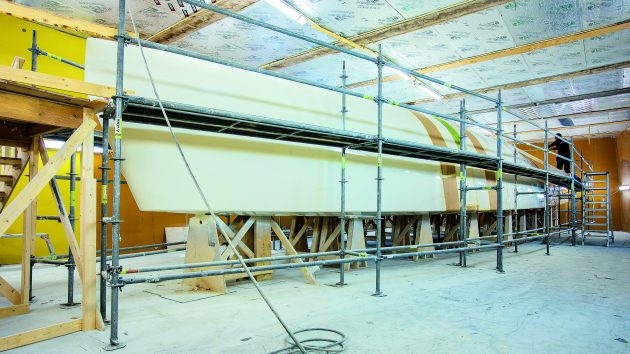
Building with pre-preg materials is efficient, but the hull must be 'cooked' at a precise temperature to cure it. Credit: Eva-Stina Kjellman
The end of GRP? Sam Fortescue looks at past, present and future boat building materials
Glance at a brochure for a new boat or walk the pontoons at the Southampton show and you may have come across some terms that didn’t mean much to you.
The art of boat building is as recognisable as ever, but the science of it is constantly developing. New materials and new techniques can make it hard to compare like with like.
Take wood, for instance: the material of boatbuilding choice for millennia.
There are still plenty of wooden boat-builders out there, labouring away in dingy sheds and halls to craft pilot cutters, rowing skiffs and other emblematic vessels of yesteryear.
But perhaps the best known of the wooden boatbuilders is Spirit Yachts in Ipswich, building thoroughly modern boats – in composite wood.
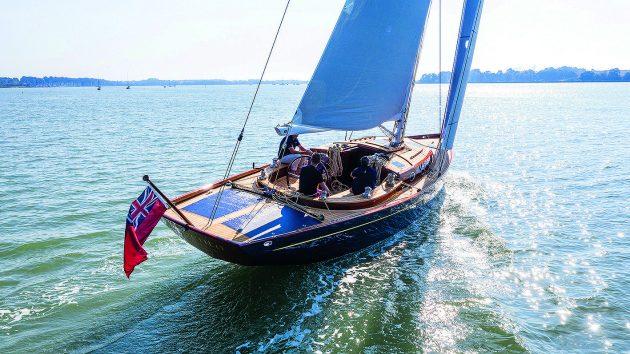
The Spirit 44E is a ‘zero carbon’ cruising yacht. Credit: Richard Langdon
‘Certainly we use epoxy resin to bond the components together, but the amount of resin used is minute compared to GRP or carbon,’ says founder and head designer Sean McMillan.
‘Both carbon-fibre and GRP rely totally on being saturated with a high density of polyester or epoxy resins to impart structural integrity. Wood, whilst also a linear fibre material, is cross-linked with a cellular structure entirely created by nature and has full structural integrity in its own right.’
In fact, the 1.6-tonne Spirit 30 daysailer employs just 73kg of resin and 12.2kg of hardener in its entire construction.
‘In 20 years’ time, when GRP has become socially unacceptable – not to mention any future end-of-life legislation – who knows, we may look back and see the last 60 years of GRP boats as a historical niche,’ finishes McMillan defiantly.
Another example is racy French builder RM Yachts, whose boats are famously swift, with offshore hulls designed by Marc Lombard.
And yet they are built in plywood and epoxy.
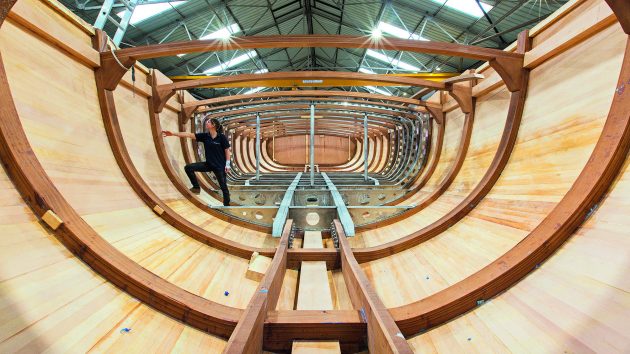
Thought every Spirit yacht us built of wood, it is a composite of glue and epoxy sheathing.
It is flexible, robust and far more sustainable than standard glass-reinforced plastic.
Sheets of laser cut Okoumé plywood up to 22mm thick are bent around a mould and epoxied to plywood structural members.
The whole lot is also epoxy sheathed for longevity.
It’s a technique which means that the brand-new RM 1380 is 9.8 tonnes light – slightly less than the comparable X4-6 from X-Yachts.
‘Plywood is the soul of an RM. It a very useful material, allying a good stiffness with lightness – perfect for building the hull and the structure,’ says head of engineering Edouard Delamare.
‘But plywood is nothing without epoxy, because it ensures the waterproofing – vital in a marine environment.’
Boat building using glass-reinforced plastic
Many series production yards, from Beneteau to Bavaria , still use the most basic form of wet lay-up – splurging resin on to mats of glassfibre with a roller to get them well wetted out before laying down the next layer of glass.
It is very hard to control how much resin is applied and there are often air pockets between layers.
For this reason, hulls built this way tend to be overbuilt and heavier.
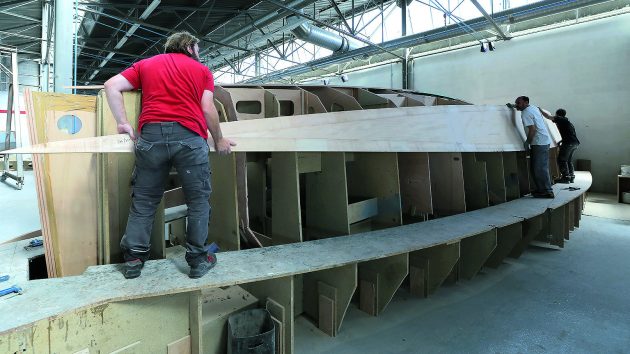
RM Yachts is unique in building its offshore yachts in plywood and epoxy
Polyester is the cheapest and most commonly used resin, but it can bond with water, creating the problem of osmosis.
That’s why isopthalic gelcoats are applied to the outside of the hull, to act as an effective barrier to moisture.
Vinylester creates many more bonds than polyester and is reckoned to be up to three times stronger, but it costs more too.
And epoxy is the best performing resin of all, used only in high-quality lay-ups. All are pretty toxic, and sport the ‘dead-fish’ icon on the side of the tin.
When vacuum infusion emerged as an industrial technique in 1990, it allowed boatbuilders to use less resin and spread it more evenly around the finished panel for greater strength.
But it generates a lot of waste, because each infused part has to be prepared with a host of plastic layers.
Besides the plastic of the vacuum bag itself, there’s a breather layer to distribute the resin and a peel ply to stop it sticking to the infused part; a thick bead of sealant tape; disposable feeder tubes are required every few inches, and many of the vacuum tubes must also be binned.
The technology has not stood still, though, and there are now reusable vacuum bags made from inert silicon, for instance.
Some bags have the mesh structure necessary to spread the resin built in, while the aerospace sector has pioneered the use of PTFE membrane that stops resin clogging up the vacuum pump side of the system.
Sweden’s Arcona builds its fast cruisers using vacuum infusion, and has for many years.
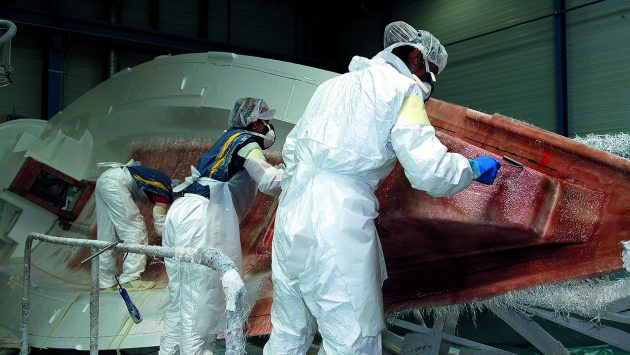
Hand lay-up is a process that has changed little over the years of boat building
But in order to add strength and stiffness, it laminates in a steel support frame amidships to transfer the loads from the rig into the keel.
Improvements in lamination techniques mean that the boats are lighter than ever.
Late Arcona designer Stefan Qviberg said the current Arcona 40 displaced a whole tonne less than its equivalent a decade earlier.
Other boat builders use other types of reinforcing for the high-load areas of the hull.
Aramids like Twaron and Kevlar often feature, as do selective areas of carbon-fibre on stringers and around keel bolts and chainplates.
High-end yacht builder Baltic uses carbon reinforcing, for instance, to add strength without extra weight.

Vacuum infusion uses less resin but creates a lot of plastic waste
Performance catamaran brand Catana likewise uses Twaron and carbon in its lay-up to save hundreds of kilos; some 700kg in the old Catana 47.
Some claim that aramid reinforcing makes a hull safer, for example in the event of collision with a container, but others refute this.
Naturally enough, carbon is still the ultimate performance material because of its blend of strength, stiffness and light weight.
It is also prohibitively expensive relative to other fibres and very resource-intensive to produce, as it requires temperatures up to 3,000º C and a plastic feedstock.
The bulk and waste of the infusion process has led to another step forward in the form of so-called pre-preg materials, where the sheets of fibre used to strengthen the hull come ready-coated with a pre-catalysed form of the resin that reacts very slowly at room temperature.
Instead of needing to mix epoxy with hardener and reduce its viscosity with toxic styrene to draw into the mould, a precisely-controlled curing process activates and sets the resin.
The result is a stronger, lighter laminate than can be produced through wet lay-up.
Gurit’s SPRINT system goes a step further by sandwiching a thin film of heat-activated resin between two layers of fibre.
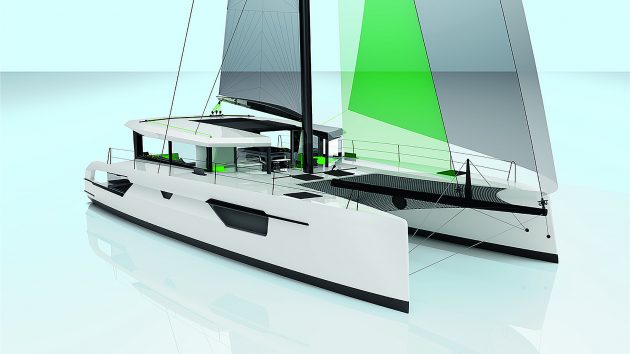
Windelo uses basalt fibre to strengthen its hulls during the boat building process. It is said to be much less carbon intensive than using glass
The advantage of this is that the fibres remain dry until curing so air can be more easily removed under vacuum to produce a laminate with a void content of less than 0.5%.
Baltic Yachts uses this technique, building an oven around its hulls to cure them.
‘With one or two exceptions, we haven’t infused a boat for some time,’ says CEO Henry Hawkins.
‘Using Sprint and pre-preg materials saves weight compared to vacuum infusion. With hand lay-up, generally more resin is mixed than needed and a lot gets discarded. This is the same with infusion where resin is lost or wasted in the plastic hoses and pipes and breather film and within the distribution channels.’
Continues below…
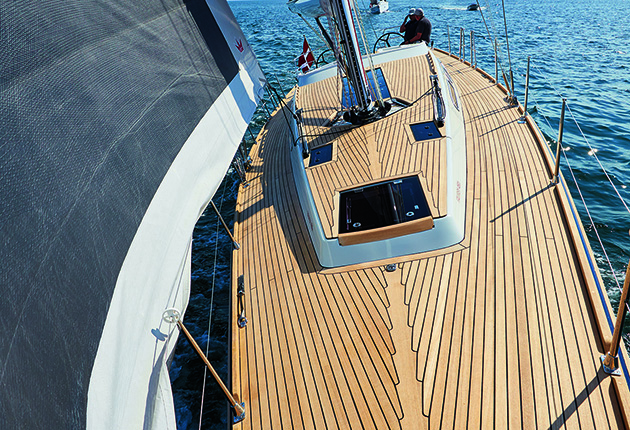
The dirty truth about teak
Teak is beloved by boat owners and shipyards for decking and yacht building, but any claims that it is sustainably…
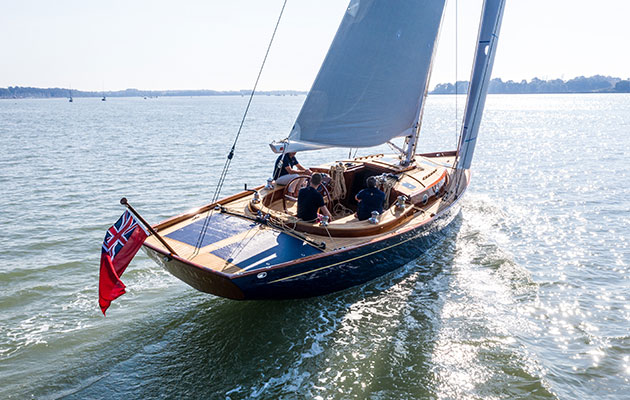
ON TEST: Spirit 44e – the sustainable future of sailing?
A wooden boat that blazes a trail for modern technology and sustainability sounds too good to be true. Theo Stocker…
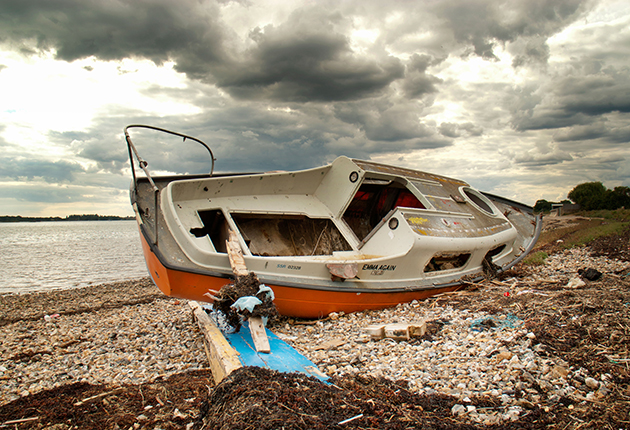
What’s the future for derelict GRP boats?
With 9,000 GRP boats abandoned in Europe each year, finding disposal solutions isn't easy. Could new technologies be the answer?…
Even at this sharp end of the composite business, rapid advances are being made – driven by aerospace and Formula One.
‘We can now take away the expensive autoclaves and ovens – they can cure at ambient or 40-60ºC,’ says Ashley Parkinson, a research engineer with the UK National Composites Centre.
‘It’s a more expensive process to use, but in the high-performance market, it’s worth it.’
Greener composites
Now, there is nothing particularly sustainable about producing glassfibre – a technique that involves heating raw silica to 1,370º C, then pultruding the molten strands onto a bobbin.
You can use some recycled glass to lower your emissions, but it is an energy intensive process and it is very hard to extract the raw materials from end-of-life fibreglass.
Swiss supplier Bcomp tested alternative natural fibres 10 years ago, when it was a start-up in a garage.
‘Flax turned out to be the best in terms of mechanical properties, soil usage, water requirements and overall performance,’ explains marine and industry manager Paolo Dassi.
It actually locks up carbon rather than producing it – as much as 500g of CO2 per kilogram of flax.
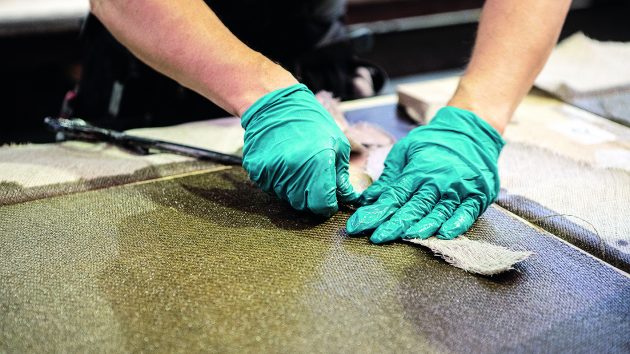
Precise cutting is key to reducing fibre wastage in boat building
‘The plant acts as a CO2 sink during its growth. This completely offsets the CO2 emissions of the manufacturing stages.’
Bcomp’s extraordinary growth began when it managed to process the flax stems to be of uniform size and flatness, replicating the grades possible using glassfibre.
Its AmpliTex product is available as a unidirectional, stitched biaxial or woven twill, ranging from 200-500gsm.
In lamination it is 50% stiffer than glass and just a little weaker, making it an ideal substitute.
Couple this with an extra flax mesh called PowerRibs, and you end up with a composite that closely resembles carbon, but with just 25% of the emissions.
AmpliTex has already been used in niche boat building projects, including the glorious Flax 27 daysailer by Green Boats of Bremen, which sports cork decking.
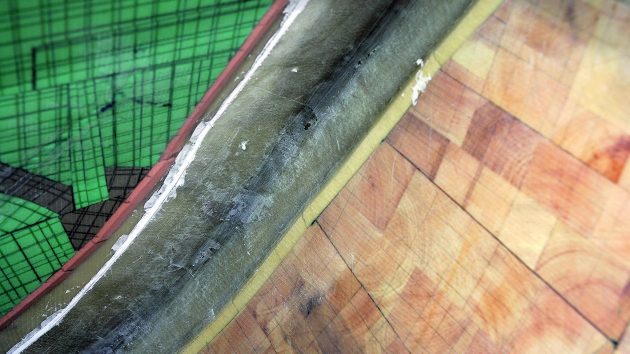
Foam sandwich hull construction (green) or balsa core (wood) is much stronger, for little extra weight. Credit: Graham Snook/Yachting Monthly
It was a key part of the lay-up of the new Café Racer 68 from Baltic. Although her hull is in carbon, 50% of the structural members were in flax composite.
France’s Windelo has taken a different tack in its catamarans.
It uses basalt fibre – made from melted volcanic rock – which ‘is slightly stronger than E-glass and just one-10th as carbon intensive to produce and use’.
Its first 50-footer has a hull that also features a recycled PET foam core for strength and stiffness. But it is not just the fibre that is being decarbonised.
So-called ‘green epoxies’ have been developed, where a significant chunk of the synthetic oil-derived molecules of the resin are replaced by bio-sourced molecules.
Gurit’s Ampro for hand laminating is 40% bio derived, for instance.
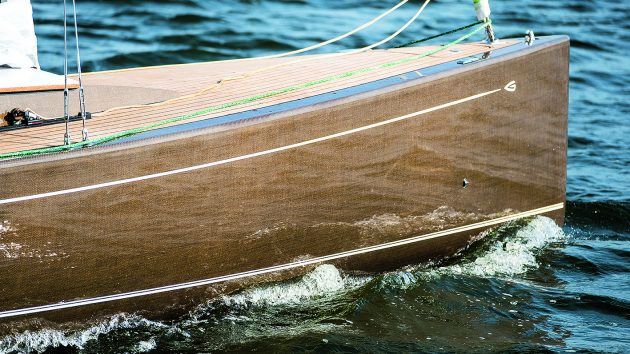
Green Yachts focuses on environmentally-friendly boat building techniques. Its Flax 27 is built of sustainable flax fibre
And the ProSet range from West Systems includes epoxies containing up to 30% bio molecules.
They can essentially just be dropped into any process that would have been suitable for the equivalent synthetic resin.
‘Any customer that is familiar with epoxy processing, vacuum consolidation or post curing will be very familiar with the process,’ says David Johnson of Wessex Resins, European manufacturer for West.
‘Even wet lay-up with no vacuum bagging.’
There is a modest cost increase, but it amounts to less than 25% compared to a standard epoxy, and a drop in the ocean of the boat’s overall build.
‘Bio-based epoxies are more expensive because there’s more sophisticated chemistry involved,’ says Johnson.
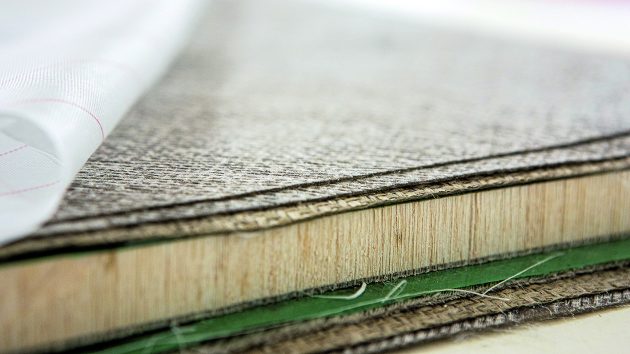
Pre-preg flax fibres being laid up around a balsa core
‘Compared to building a boat in vinylester or polyester, you can use slightly less material because of the superior qualities of epoxy. The end cost differences are negligible and there are benefits in lighter weight: you become more efficient, and the loads are less.’
Suppliers like Gurit are also finding ways to substitute the synthetic foam core used in sandwich hull construction.
Standard foam is made of virgin PVC, with all the associated environmental pitfalls.
Gurit has developed more renewable alternatives using up to 100% recycled PVC and balsa wood.
Builders from Arcona and X-Yachts to Bali and Gunboat catamarans use foam cores in their lay-up to build boats that are stiffer and lighter than they would be otherwise.
Away from composites
Some innovative new boat builders are going in another direction altogether, eschewing the by-now traditional GRP for something that can be genuinely reused repeatedly.
Start-up Vaan is building its 42ft R4 catamaran out of a grade of aluminium alloy commonly used in window frames and road signs, so up to 60% of the hull is already recycled.
‘There’s no way to distinguish it from virgin material,’ says Vaan founder Igor Kluin.

Vaan uses a high proportion of recycled aluminium to build its hulls, which can then be easily recycled
It hasn’t been easy to secure supplies, however. That’s partly because window frames last for 50 years or more and also competition with other sectors.
‘In the short term the costs are higher because there are so many people jumping on the bandwagon, but it has only 5% of the energy use of virgin alloy, so in the end it should be cheaper.’
Vaan’s novel approach to sourcing more sustainable materials extends to the interior finish as well.
It uses a pineapple leaf fabric instead of leather, plentiful European poplar for cabinetry, cork instead of teak decking and recycled PET.
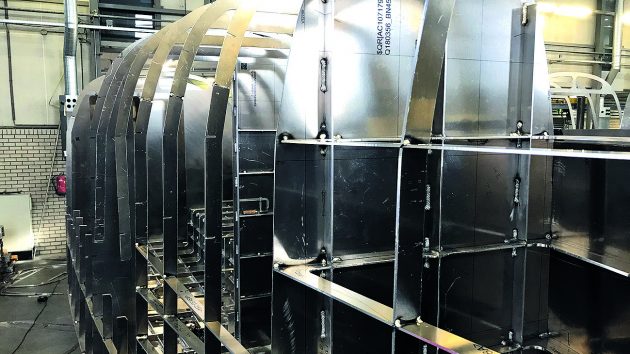
Greener boat building: A hull made from recycled aluminium
Parts of the boat are 3D printed – something that higher end brands are doing more and more of.
‘Recycled industrial PET is being 3D printed for the back of the Vaan spoiler because it produces a lower volume than moulding,’ says Kluin.
‘We want to see if it can become load bearing. We’re also 3D printing with aluminium, too. It’s useful for smaller structural elements that are hard to reach and would traditionally have been milled.’
Recyclability of boat building materials
Besides wood, all forms of composite suffer from the same problem; at end of life, it is very difficult to separate the component materials for re-use.
This is why using materials such as steel or aluminium can make sense, despite the higher environmental cost of the virgin metal. They can be reused repeatedly.
The composite recycling systems developed to date, which include pyrolysis, burning and shredding, are all unsatisfactory because of the energy intensity of the processes or the fact they yield a lower quality material that has to be downcycled.
In principle, it is possible to use resins that melt again at high temperatures and can be collected, refined and reused.
Elium resin from Arkema is capable of exactly that, and is already being used in recyclable wind turbine blades.
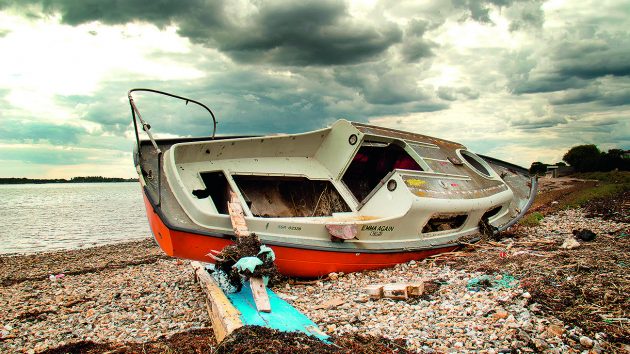
Laminate are expensive to separate for re-use. Credit: Rob Wilkinson/Alamy Stock Photo
They even built a 6.50m Mini Transat boat from it.
The process also yields reusable glass, but carbon and flax don’t support the heat: carbon loses as much as two-thirds of its strength and flax simply combusts.
However, an Australian study has shown how carbon-fibre composite can first be heated without oxygen in a pyrolysis chamber to burn off resin, then oxidised to yield carbon-fibre with most of the strength of virgin fibre but only 10% of the environmental impact.
Cured laminates can also be separated using a chemical process proven in the lab at the National Composites Centre, with a big vat of acetic acid.
Portsmouth University is researching enzymes to decompose plastic, starting with plastic bags.
The approach could eventually handle boats as well.
‘You have to find the right enzyme that works for snipping the molecules of a particular polymer. Practically, it’s a decade away,’ says Ashley Parkinson of the NCC.
Home » FAQ Solving Boat building and Repair Problems with Wood Epoxy
FAQ Solving Boat building and Repair Problems with Wood Epoxy
This Epoxy FAQ solves typical problems to save money and effort for boat building and boat repair. How to use epoxy resin, fibreglass, wood and plywood for home boatbuilding. And some boat restoration and racing prep tips.

How to Choose Epoxy or other resin or glue and fallacies about salt and epoxies that “soak in”
A 30 year review of epoxy for built boats.
How the 1970s showed us how epoxy changed things for plywood boats – dramatic reduction in maintenance.
Epoxy vs Polyester Resins
More about why wooden boats and canoes require much less maintenance now – superiority of epoxy resin.
Why Epoxy comes out on top of Resorcinol vs Polyurethane and modified PVA+ Glues
There are still legitimate ways to use non epoxy glues on boats – where are they best and where is epoxy best?
Preventing Rot Pt 1- Don’t throw salt inside the boat – PLEASE!
Salt inside a light boat just about ensures that rot is down the way – what are the better ways of reducing the risk of wood rot?
Preventing Rot Pt 2 – The epoxies that “soak in” fallacy
Epoxies that soak into the timber are a waste of money in most cases – this explains why CPES and Everdure have a very interesting use on boats based on their weak wood protection.
Eliminating Screws and other Fasteners – save money and do a better job
Amazing fast building and repairs purely by elimininating permanent fastenings
Are 1 to 1 (1:1) Epoxys any good for boat building
How to recognize when epoxies have been cheapened and performance compromised
Using Epoxy for Wooden Boat Building and boat repair
- Fiberglassing Boats
- Glass Taping Chines
- Glues and Gluing Wood
- Coating with Epoxy
- Laying Teak Deck overlay veneer
- Repairing Wood Rot
- Epoxy Boatbuilding FAQ
Epoxy fiberglass Method 1 – Small Areas
How to epoxy fiberglass chines or joins between plywood boat panels
Epoxy fiberglass Method 2 – Complex Curves
How to do small complex areas on boats and canoes with epoxy/glass – double bias tapes and why does my fiberglass bubble on the corners and edges?
Epoxy fiberglass Method 3 – Large Areas – reducing the emotional pressure of the epoxy going off
Epoxy going off too fast when there are large hull areas to be glassed or coated – it is not hardener speed – it is boatbuilding work practice.
Saving Labour by epoxy precoating plywood sheets
And how precoating plywood sheets or boat and canoe panels saves epoxy and makes sanding easy –
How do I apply epoxy glue fast, accurate and clean
Saving Material and Labour with epoxy by accurately and quickly placing epoxy where it is needed.
Painting and Varnishing
Choosing between paint and varnish and one and two pot for your sailboat, powerboat or canoe – and how epoxy reduces that labour
The secrets of fast plywood boat assembly
Cordless drills for timber structure assembly – speed up your boat building methods
Teak Decks over plywood – methods techniques and a trick
How to use Sikaflex and Epoxy for Teak Decks over Plywood substrate for yachts
Teak Boat Decks and Sikaflex, 5200 etc
Epoxy curing problems
Why is the epoxy still soft two days later?
Preparing timber for gluing or fiberglassing – rough is definitely bad!
Why sandpaper coarser than 100 grit causes bond failures in wood gluing – and sharp tools are OK too – boatbuilding techniques.
Making epoxy flow in cold climates
A lightbox to keep epoxy warm so it spreads easily and pumps well in cold weather boat building
Avoiding starved epoxy joins for scarf and other joints
How to epoxy glue endgrain scarf joins and other gluing for full strength – many failures are from dry joints by not understanding the problems of end grain – boatbuilding techniques
Racing Dinghy Boat Repair and Restoration including sailing dinghy case studies
- Mirror Dinghy stitch and glue Boat Repair,
- Sabre – preparation of an older boat for racing
- International Cadet – redecking
- Scantlings for old boats
Fixing up old boats and making new ones better
Compilation of repair of older sailing dinghies and canoes and bonus finishing information – if you have an old racing dinghy to repair or restore this shows you how.
Step one in Plywood Sailing Dinghy , sailing canoe and Catamaran restoration – deciding if it is a keeper
Racing Dinghy repair and restoration step 1 – Is it a keeper? Restore an old cheap plywood racing boat or ditch it?
Step 2 – Triage – what to fix and what not to fix when restoring an old racing dinghy, canoe or plywood catamaran
Reducing Centreboard Maintenance with Centrecase and rudderbox Padding
International Cadet plywood racing dinghy restoration – change a cheap boat into a fast performer.
Fixing up an old Plywood dinghy – Mirror dinghy (plywood/glass taped seams) – lots of work and choosing what is important to fix and what to leave until later.
Fixing up an old Plywood dinghy – Sabre dinghy – minimising the work and racing sailing Dinghies and Yachts. The low stress way of doing very well !?!
How to remove OIL and DIESEL that has soaked into Timber Boat Hull
Why I hate Silicon sealant on boats
USL Code for finding sizes of timber parts of traditionally built boats of larger displacement such as workboats, ferries, trawlers and cruisers
Can I use Bamboo for small boat spars? Guidance on Open/Oz Goose Website
Wooden Boat Building Advice, General non epoxy FAQ – cedar strip, decks, lightweight small boat building advice
Torture Boards – how to get cedar strip or deck framing smooth so decks aren’t lumpy.
Scantlings for a very light balsa or Paulownia canoe can show us what we can get away with
Selecting timbers to build a canoe or kayak in Australia. Paulownia, Jarrah, Cedar – good or bad. Epoxy Strip planking and plywood boat building
Join Plywood for Boat Decks – Don’t Copy Housebuilders! Boat Building knowledge
Lightweight timber for lightweight small boats – which timber? Paulownia (Kirri)
Fast building two plywood canoes using Duct tape as an alternative to cable ties or copper wire
In Praise of FAST wooden boat building methods – why I hate boatbuilding
Design and Plan info – Altering or modifying boat plans, Birdsmouth spars, Dory design, Collision, boat strength, Canoe design
Is it ok to shrink or stretch an existing boat design.
Honey – I shrank the boat and it don’t work no more – and the folly stretching and shrinking boat designs when building
Old plywood boat designs vs modern designs
Older boat designs (Hartley etc) vs Modern Designs (epoxy technology) – changes in boat building methods to dramatically reduce timber and labour
Buying a Boat Plan and what you should know
How the Small boat plans business works and, perhaps, how to use it to your advantage as a home boatbuilder.
Birdsmouth Spars
Should I build a Birdsmouth mast with butt joints or scarf joints?
Design of specific boat types – the good and the bad
Canoe Design – features of plywood, strip planked, fiberglass canoes and sailing and paddling canoes
Will giving my boat, surfboard, windsurfer, sailboard or yacht a golfball dimple finish reduce drag?
Is it sensible to design a lightweight plywood Dory for rowing or sailing?
Cedar Strip canoes and boats, Epoxy and Impact
Building cedar strip boats strong enough to take impact – canoes and sea kayaks and beach landings, how to avoid overbuilding (expensive and you still have to carry the beast!
Impact strength of wood and plywood boats – how much fiberglass will protect my plywood boat from rocks, stumps, logs and other hazards – How to repair holes in plywood small boats almost invisibly
SAILING and learning to sail – how to get control of the boat.
This Section Sponsored by our Really Simple Sails Sailmaking
Learn to sail – choosing a first boat
How to choose a first boat – Should I buy new, build or buy secondhand?
TABLE OF CONTENTS – Sailing Lessons
Our growing list of free online sailing lessons – more approx weekly, fundamentals tiller and how to feel the sail.
Fundamentals 1 – Lesson on Tiller handling for Sailboats
Fundamentals 2 – Finding the power of the Sail. What it feels like. And a practical simplification of the Points of Sail.
Sailing Lesson 1 Manoeuvres
Tacking And Gybing – Turning Around – Taking the pressure off.
Safe Gybe Technique and Fast Gybe Techniques.
Sailing Lesson 2 Upwind
Basic Sailing Upwind – Light and Moderate Conditions
Sailing Upwind in Gusty Conditions – when a gust hits.
Sailing Upwind in Gusty Conditions – when a gust ends (Technical)
Sailing Lesson 3 Downwind
Downwind Control in Gusts
Some useful sailing tips for beginner sailors
Some basics of learning to sail that often get ignored at the beginning.
How to make it easy to get kids to wear life jackets – and a how the world’s best sailor drowned.
Why wearing lifejackets is essential – and how to get kids to wear their lifejackets!!!
Some more advanced rigging, boat handling and sailing tips and tricks
Video Tutorial – Gaining downwind control and safety through rig trim. Applies to unstayed mast rigs, Cat rigs, ketches and yawls
How to Set up lugsail and spritsail rigs (also lateen sails) for excellent performance – focus on balance lugs but applicable to standing lugs and Lateen.
Construction and Building Questions from the Early OzRacer days.
Relate to OzRacer, OzGoose and general boat construction and sailing.
The Sailing Gear Arms Race and the Oz Goose
Why exotic second hand parts of other boat should not be used on low cost boat types
Hull Structure for Plywood Boats
How light can a ozracer be built of wood and epoxy, 10kg/25lbs, the death of small boat sailing in australia. too expensive., designing sailboats to be stiff. oilcanning and twisting and the role of torsion boxes – epoxy for wooden boats including repairs , plywood , thickness, puncture protection, what are the correct plywood thicknesses for robust small boats, peter on how much resistance to puncture does ply really need to have, centerboards and leeboards, leeboards vs centreboards in small boats, why the centreboard position in scows is different from pointy bowed boats and why it ended up not making a difference to the ozracer, are there shallow draft options for the oz racer – my local waters are tres shallow, which is better – a swinging centreboard or dagger board for small boats, naca foils and the performance advantages, hull design, discussion about the extreme aft location of the oz racer centrecase, capsize and recovery in oz racers and oz geese, why we don’t use mainsheet cleats and design for capsize and economy., rig, fittings and sail, more on planing and the behaviour of polytarp sails in stronger wind., photo gallery of rigging a ozracer or oz goose and other lug rigged small boats to show how to get the right sail shape – sprit rig – oz goose website, photo gallery of setting up a lug rig for efficiency – not an ozracer or ozgoose but same principles, sailing tips to get the most out of the boat., ozracer, ozgoose and planing – spray in the face – wind in the hair, sailing upwind efficiently – how fast in a non trapeze boat, working out how well your small boat performs upwind – leeway, tacking angle, pointing angle.
Log in or Sign up
You are using an out of date browser. It may not display this or other websites correctly. You should upgrade or use an alternative browser .
an2reir : 10 m SCOW Sail Yacht Cold Molded Wood&Epoxy Construction Architecture&Design Andrei Rochian
10 m SCOW Sail Yacht Cold Molded Wood&Epoxy Construction according to Gougeon Brothers book on Wood & West System Epoxy boat building Lifting Keel hydraulic system ; hybrid electric propulsion Architecture&Design Andrei Rochian Here is the video https://www.youtube.com/watch?v=lClStmLa2cQ #woodenboat #holzboot #woodenboatdesign #woodencow #woodensailboat #woodsailyacht #bateaubois#woodenboat #holzboot #woodenboatdesign #woodencow #woodensailboat #woodsailyacht #bateaubois #barcadilegno #barcadilegnodisegno #barcodelegno #barcadilegno #båträ #träbåt #träbåtdesign #träko #segelbåtavträ #träseglabåt #botesdemadera #diseñodebarcosdemadera #vacademadera #barcodevelademadera #yateavelademadera #barcaboia #Yacht #Velier #Barcă #Navigație #Vele #Inovație #Ambarcațiuni #Bărci #Iahturi #Mare #Scow #Sailboat #Boating #Yachts #YachtDesign #Innovation #bateau #voilier #voilierscow,#boat #yachtdesign #boatdesign #SailYacht ,#sailboat #yachtdesign #boats #bootdesign, #segelyacht #bootsbau #Ambarcațiuni #Bărci #Iahturi #YachtDesign #Nautical #bluewatercruiser #tourdelatlantique #voilierenbois #voilierecologique #mer #liveonboard #sailing #cruising #sea #woodenboat #sailingboat #microcruiser #sailaroundtheworld #microcruiser#yachtdesign,#boatdesign,#design,#engineering,#bordeaux,#hongkong #iahturi ,,#vele,#veliere,, #barca ,#yacht,#sailing,#bateaux,#voilier #Yachts #YachtDesign #Boating #Yachts #YachtDesign #bateau #voilier #voilierscow#boat #yachtdesign #boatdesign #architectebateaux #SailYacht #SailBoat #YachtDesign #Boats #Yachts #BootDesign #Segelyacht #Bootsbau #Ambarcațiuni #Bărci #Iahturi #Sailing #Yachting #boating #Bootsbau #Ambarcațiuni #Bărci #Iahturi #Sailing #Yachting #boating #보트디자인 #보트 #세일요트 #보트제조 #요트디자인 #목조설계 #미니크루저 #船舶设计 #游艇设计 #帆船 #帆船游艇 #船 #船隻設計 #遊艇設計 #風帆遊艇 #風帆遊艇 #ボートデザイン #ボート #ヨットデザイン #ボートデザイン #セーリングヨット #セーリングボー #ボート Posted by: an2reir - website: https://www.facebook.com/fifityboatdesigns
- Information
Note: EXIF data is stored on valid file types when a photo is uploaded. The photo may have been manipulated since upload (rotated, flipped, cropped etc).
- No, create an account now.
- Yes, my password is:
- Forgot your password?

Building, restoration, and repair with epoxy

Plywood Boat Construction
Effects of fiber reinforcement — stiffness vs. weight, by bruce niederer — gbi technical advisor.
One of the most widely chosen materials for boat building projects is plywood. It is easy to work with, it is relatively inexpensive, and many kits and plans are specifically designed for plywood construction. Often times a fiberglass skin is laminated over the outside of the hull, primarily to provide some abrasion resistance, but also to add a measure of stiffness, because we all know stiffer is faster! And herein lies the downside: Fiberglass and epoxy add weight to the boat. How does one resolve this contradiction of strength versus weight?
Under the watchful eye of Bill Bertelsen (Project Engineer), the tech staff utilized our Hydromat test apparatus to gather fundamental stiffness information on 2′ x 2′ plywood panels. We tested commercially available 3/4″ seven-ply Lauan and Okoume plywood.
First, the uncoated panels were weighed and measured for stiffness. Next, a single layer of 6 oz. 0-90° fiberglass cloth was applied to one side of the Lauan panel using WEST SYSTEM® 105/206, and a single layer of 5.7 oz. 0-90° carbon cloth was applied to one side of the Okoume panel also using 105/206. The weight of each panel was taken again. The fundamental stiffness of each panel was recorded in two configurations. First, with the fiber reinforcement in compression, as if it were on the outside of the hull, and then with the fibers in tension, as if it were on the inside of the hull. Finally, another single layer of each cloth was applied to the other side of each plywood panel as before, the weights were taken, and the panels were tested for fundamental stiffness.
The stiffness of a panel is determined by measuring the amount of panel deflection at the center of the panel vs. the amount of contact (or hydrostatic) pressure within the water filled bladder of the Hydromat that is required to deflect the panel a given distance. The greater the contact pressures the stiffer the panel. Imagine how a hull section would flex when slamming into waves as the water presses in on the unsupported spans between bulkheads or stringers. These areas are where stiffness counts.
The graphs below depict the increase in stiffness measured as the panels were reinforced as described above.
In comparing these graphs, we discovered that:
- The basic stiffness of the Lauan panel was 9% more than the Okoume panel.
- Both graphs show that each panel was slightly stiffer if, when only one side was reinforced, the fibers were placed in tension as if on the inside of the hull.
- The Lauan with one side glass reinforced improved stiffness by 18% and 23% (depending on fiber orientation) with a 7% increase in weight.
- With both sides reinforced, stiffness increased by 32% with a total weight gain of only 11%. Not a bad trade off.
- The Okoume reinforced with carbon fiber performed even better. When one side was reinforced, stiffness increased by 28% and 34% (depending on fiber orientation) with a corresponding weight increase of only 5%.
- When both sides were reinforced stiffness increased an impressive 66% with a total weight increase of 11%! This is a very good trade off.
Of course, carbon costs more than fiberglass, so depending on the application and intended use, the cost of materials may become significant. But, from an engineering viewpoint, we hope this data helps our readers to make more informed decisions when building with plywood.
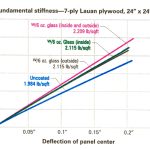
WHY DO SPIRIT YACHTS BUILD WITH WOOD
Wooden sailing yachts.
With so many composite products on the market today, the Spirit team is frequently asked about the intricacies of building modern yachts with such a traditional material. In summary, wood is the only natural boat building material offering beauty, impressive strength to weight ratio, flexibility and durability.
However, we’re aware that here at Spirit we’re pretty biased, so here are the facts….
Wood offers incredible strength without the weight of most fibreglass products
If used in combination with epoxy resin saturation (as we do at Spirit), and when considering the overall yacht structure, wood is a far superior material to the modern composites used across our industry today. With its fibrous grain imbedded in a naturally intricate matrix, wood offers impressive strength without the accompanying weight of most fibreglass products.
When comparing the strength to weight ratio of a wooden yacht to a fibreglass composite boat it is necessary to consider the two construction processes. When building a fibreglass composite structure the hull is either made up of multiple layer of heavy E-glass, or a core is added such as foam or balsa. These cores increase the complexity and cost of the structure, and also require additional reinforcement in the form of pad layers where bulkheads and loaded structures touch the hull. As E-glass is heavy (but low cost) the result is an equally strong structure but with a weight penalty and none of us want to sail with excessive weight on board. With wood, the skin thickness comes as part of the material, with the added advantage that timber can sustain impacts with far less damage to the structure due to the wood’s complex multi-directional grain. At Spirit we also don’t have to use composite moulds as all our yachts are handcrafted using wooden ring frames, thus allowing us to tailor the design to the owner’s requirements.
Wood offers impressive flexibility and durability
The natural matrix of wood offers exceptional flexibility, allowing it to easily be shaped, formed and bonded. This allows us to create intricate shapes without the need for heavy reinforcement.
Spirit hulls and decks are internally finished by hand, unlike most composite yachts where a lining is required to complete the inside of the hull. Not only aesthetically beautiful, the natural wooden finish of the interior of a Spirit yacht provides excellent insulation, both thermal and sound, due to the impressive vibration absorption characteristics of wood. The added thermal insulation also means our yachts don’t suffer from the condensation that affects many fibreglass composite boats.
Spirit’s high quality timber and sustainability credentials
Wood is at the heart of everything we do at Spirit and Sean (McMillan) has always been meticulous in sourcing the highest quality timber without compromising on sustainability . We are committed to only dealing with responsibly managed forests and regulated suppliers.
Boundless beauty
We may be biased but with their iconic clean lines and warm wood finishes there is no denying the outstanding beauty of Spirit’s modern classic yachts . The ultimate combination of the stunning wooden aesthetics with modern appendages and the latest in sail technology means Spirit yachts have beauty, style and performance; what’s not to love?
RELATED ARTICLES
Spirit p35 e.f.
STAY IN THE LOOP
" * " indicates required fields




IMAGES
VIDEO
COMMENTS
Matt Newland of Swallow Yachts tells me their Whisper 300 retro-style planing motor cruiser has demonstrated that at sizes above 30ft an epoxy/timber construction can compete directly on labour ...
4) Fresh looking design, large cockpit, plenty of utility space under the deck at aft of the boat 5) I had a wooden/plywood/epoxy boat before, and I like these materials more than polyester or other construction materials, at least for warm waters sailing.
RM Yachts' plywood-epoxy sailboat construction technique. RM Yachts has over 30 years of experience as a French sailboat manufacturer. One of the originalities of our modern cruising yachts is that they are made using plywood, which is assembled on a jig. Our plywood is made in France and comes to us from a factory which supplies laser-cut ...
The Gougeon Brothers on Boat Construction: Wood and WEST SYSTEM® Epoxy was first published in 1979. As originally conceived, the book was an introduction to the techniques of "modern" wooden boatbuilding popular from 1960-1980. Its focus, as its title suggests, was how to mate wood with epoxy to form a composite that has
This renowned boat construction book was written by epoxy pioneer Meade Gougeon, a founder of Gougen Brothers, Inc. Decades of experience building with wood and epoxy are compiled in this classic on wood/epoxy boat building, popularly known as cold molding.Extensive chapters describe lofting, safety, tools, and construction methods with the aid of hundreds of detailed illustrations and ...
Wood-Epoxy Construction. Plank-on-frame boats still have a strong cult following and a relatively large number of older wooden yachts are sailed and maintained by devoted owners. ... Wood-epoxy boats can also, of course, be found on the used-boat market. Recently built boats are relatively rare and normally command a significant premium, but ...
RM Yachts is unique in building its offshore yachts in plywood and epoxy. Polyester is the cheapest and most commonly used resin, but it can bond with water, creating the problem of osmosis. That's why isopthalic gelcoats are applied to the outside of the hull, to act as an effective barrier to moisture.
This Epoxy FAQ solves typical problems to save money and effort for boat building and boat repair. How to use epoxy resin, fibreglass, wood and plywood for home boatbuilding. And some boat restoration and racing prep tips. How to Choose Epoxy or other resin or glue and fallacies about salt and epoxies that "soak in"
In this video we discuss the basic principles you should know when working with epoxy and demonstrate common applications of epoxy in wooden boat constructio...
10 m SCOW Sail Yacht Cold Molded Wood&Epoxy Construction according to Gougeon Brothers book on Wood & West System Epoxy boat building Lifting Keel hydraulic system ;...
Stitch and glue boat building is a fun, fast way to build plywood boats in this video we'll walk you through the process of how to glue and tape the inside o...
We tested commercially available 3/4″ seven-ply Lauan and Okoume plywood. First, the uncoated panels were weighed and measured for stiffness. Next, a single layer of 6 oz. 0-90° fiberglass cloth was applied to one side of the Lauan panel using WEST SYSTEM® 105/206, and a single layer of 5.7 oz. 0-90° carbon cloth was applied to one side of ...
Gluing and laminating with epoxy makes your boat more durable, more affordable to build, and easier to build and maintain. Toggle menu. 1 (888) 683-1930 ... Wood and Epoxy: A Perfect Match. Epoxy, ... you don't want epoxy building up on them. If you're like me, you will want to re-use your clean up sticks, so clean them too and set them aside ...
Wood offers incredible strength without the weight of most fibreglass products. If used in combination with epoxy resin saturation (as we do at Spirit), and when considering the overall yacht structure, wood is a far superior material to the modern composites used across our industry today.
It perfectly possible to build a boat with ply, timber and fasteners. Plywood does not like fasteners. Epoxy allows you to eliminate fasteners. Epoxy also provides a tough chafe and waterresistant skin for the ply. The Elimination of fasteners and a well sealed , waterproof, ply skin is what makes a boat last a long time.
In this video Lou shows how he laminates the frames on his Norwegian built 8 Metre (1948). The wooden frames are made of parallel pieces sandwiched between t...
Modern wood boats, built with new techniques and incorporating epoxy resin systems, are now more durable and require less maintenance than fiberglass boats. These modern wooden boats are sometimes called "wood/epoxy boats" or "WEST SYSTEM boats." I will attempt to briefly explain some salient points about the modern wooden boats we are building.
Epoxy is compatible with both varnish and polyurethane finishes. For woodworking and boat building applications, coats of epoxy can be used to seal, stabilize, and waterproof the wood surface. Then, to provide the UV protection that epoxy lacks, coats of varnish or polyurethane can be applied on top of the cured epoxy.
Here is a step by step video of making a dock cleat the will last a life time.Follow along as Boat Builder Bob Emser makes a 10" dock cleat out of Ash wood. ...
Facade on May 1st Street. August 22, 1988. William Brumfield. Because of its deep connections with the origins of the Romanov dynasty, Kostroma was the frequent object of royal visits and ...
In 2015 Kostroma will celebrate all things Snegurochka from March 27-28. Located in a restored 19th century building near the waterfront, Snegurochka's Fairy Land is a snow maiden's paradise ...
Watch how to scrape off the old finish on a dinghy and then how to mix the proper amount of epoxy before you start your next project.For your wooden boat bui...
Construction works were carried out between 1824 and 1825 by A. Stepanov, while S.F. Babakin and S.S. Povirznev, two sculptors from Yaroslavl, continued working on the project from 1825 to 1827. When visiting Kostroma in 1834, Emperor Nicholas I was fascinated by the building. The Museum of Wooden Architecture was founded in 1958.